#scratch that everything is this illustration is goals!
Explore tagged Tumblr posts
Text
friendly rivalry deep dive part 1
**Reblogging to let folks know that if you are interested in reading these deep dives, you should follow this new blog, as I won’t be updating the old one. You can find links to all my deep dive posts here.**
Korean GL Friendly Rivalry is my latest hyperfixation, if you can’t tell. It’s my favorite kind of love story—a little bit twisted, but sweet and sincere deep down—and it’s a treasure trove of tropes that scratch a primordial itch in my brain. It’s also ~*dense*~ for a GL series, and practically begging for deeper analysis. There is so much going on plot-wise, character-wise, and otherwise that it’s almost impossible to catch everything the first time you watch it. Probably a little too much going on tbh but I’m not complaining! GL fans don’t often get media this juicy to sink our teeth into. So instead of feeding my obsession by watching every FMV I can find on Youtube (been there done that), I’ve decided to rewatch the series at a slower pace, picking it apart piece by piece.
Some criticism might sneak into these deep dive posts, but my goal isn’t just to write a longer more in-depth review. I already know that I love this show, and I already know it’s got problems. Instead this will be a space for thinking out loud as I try to understand the story and characters on a deeper level, because I Have Thoughts and I Must Scream. Idk how many installments there will end up being, or how much content I’ll cover per post, but I think, for simplicity’s sake, I’ll try to proceed in episode order without jumping around too much. Oh but do watch out for spoilers—I’m writing for others like me who have watched the whole series at least once.
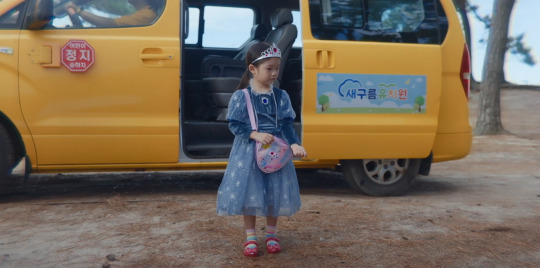
So...where better to begin than with the first scene of Episode 1? This opening scene is doing a lot. On the surface, it’s establishing Seul-gi as our narrator. This is her story, in her own words. We aren’t getting an “objective” account.
It’s also establishing style. From the first few seconds we know not to expect straight realism. There is no logical reason a child on a school trip would happen to have dog treats in her, um, royal handbag. This is the heightened realm of dreams and memories. She has the dog treats to illustrate an emotional truth. This poor girl is so desperate to be noticed that her efforts to stand out only isolate her more from everyone. (The princess dress is such a believable detail, too—you either know a stubborn kid who insists on embarrassing themselves like this, or you were that weird kid.) I’m struggling to think of a more perfect way to express that overwhelming feeling of invisibility than a dog turning up its nose at the treats in your hand.


This scene introduces some symbols that will pop up throughout the series. There’s another important dog later, and lots of water, and the princess dress comes back. I’m not sure what any of these are doing yet, but they seem intentional, not random. There’s some fun with the visual language too. We’re shown a series of snapshots in which Baby Suel-gi is always in the background or a bit out of frame. But some mysterious hand has helpfully outlined her and drawn some cute little pictures on the photos. Is she not only narrating her story, but illustrating it for us?
The thing about this scene is, while I love it and think it’s brilliant, it also doesn’t really make any sense. How hard could it be to locate a lost child in a princess dress if the parents knew which beach the school was visiting? Couldn’t they contact the nearest police station, or whatever institution deals with such cases? Or just contact every orphanage in the area? Maybe something got lost in translation, or maybe it just needed a little extra lampshading. Either way, it’s a bold move to hang the whole plot on a moment of what feels like dream logic.
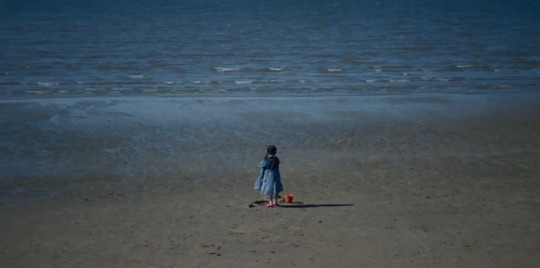
On a poetic level, though, it’s very satisfying. The cosmic irony of being separated from everyone you’ve ever known, just because you wanted a little attention, is so deliciously bleak—and on a character level, it tells us exactly what we need to know about Seul-gi. This is a girl who has been fucked up by The Gaze. (Not The Gays yet but we’re getting there.) She’s either been ignored and forgotten, or she’s stood out in ways that have sharpened her isolation. The only thing she hates more than being noticed is not being noticed at all.
This is literally just the first minute of the episode, but already this scene is gesturing at a larger character arc. How will Seul-gi react to attention from others from now on? Will she be able to overcome the trauma of abandonment? Will she ever find someone—say, a popular girl at school who skateboards, perhaps—who can see her for who she really is?
Oh no. I just wrote six paragraphs about the first minute of the first episode. I am so doomed.
#friendly rivalry#friendly rivalry meta#girls love#gl drama#gl series#korean gl#korean drama#kdrama#deep dive
10 notes
·
View notes
Text

something i wrote today on collecting grocery shopping lists:
i started collecting lists from my grocery store job mid summer of 2024, you can find them in many places, the floors, the parking lot, discarded in baskets and carts, placed on the belt amongst all their food, sometimes you’ll get the “can you throw this away for me?” and i’ll say sure, as i take it and slide into my pocket, and of course the trash cans - trash can collecting can be a risky game, but i’ve only encountered one list with gum inside of it
since beginning this collection, many of my coworkers have gotten involved, keeping their eyes peeled and on the hunt for shopping lists too, each day i come into the store i’m handed tiny bundles of paper stacks, little treasures little gifts, it’s fun to have a goal or mission that’s a bit silly, working at a grocery store can be mundane and not very exciting most of the time, i like looking at collecting lists as a part of my artistic practice, and i can see from my coworkers and friends it brings something exciting and silly to them too, at least i hope so, i believe it’s a shared joy
there is so much beauty in a shopping list, specifically for groceries, it’s a peek into someones life, interests, recipes, things they don’t want to forget, how do they check off the list, do they scratch it out? check mark? highlight? what kind of stationery and writing utensils do use?from neon colored post it notes, to torn notebook pages, cute patterned and illustrated stationery papers, a piece of cardboard, on the backs of old bills and envelopes, the store ads, we have found full left behind journals with lists in them, lost and abandoned for us to find, i could go on and on and on
handwriting and spelling is also very interesting to me, cursive, chicken scratch, doctors signature, quickly jotted down, to meticulously thought out and planned, a childs misspelling, or maybe someone forgot how to spell bannans banans bannas bananas
i believe the assortment of items one gets would be different regionally, you tend to see a lot of the same things bought here in a local pittsburgh pa grocery store, grocery staples, milk, bread, eggs, etc but they are small parts of a big puzzle, a mystery to solve, what is this person making for dinner? do they have a special event? a birthday? i hope they remembered their medication, i hope they enjoy the tuna noodle casserole they have planned
lists can be like poems, sometimes they are poems, sometimes they are very emotional, people tend to take other kinds of notes on lists too, these feel like treasures but also a bit strange how it’s fallen into my hands, i glue or tape each list into a book until it’s full and start another, i share with coworkers during get-to-gethers, peek inside the lives of our customers with me
what does the average customer think happens to their tossed list? most likely to be vanished, discarded, never seen again, unlikely they are expecting me to be pulling them out of the trash to keep? maybe this is exactly what they expect, maybe they create beautiful lists hoping for this exact thing to happen
i am a believer in we must find beauty in everything
bread, milk, and eggs
6 notes
·
View notes
Text
The Law Of Attraction For Kids Review - Is It Legit?
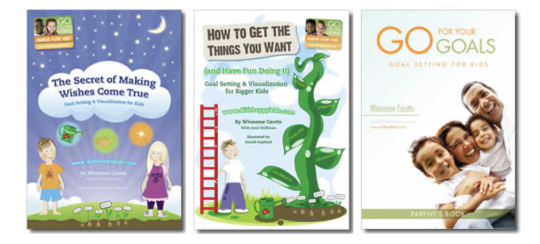
Discover how The Law Of Attraction For Kids program can guide children to dream big, set goals, and build a lifetime of happiness and success. A positive, in-depth review inside!
In this heartfelt review of The Law Of Attraction For Kids program, find out how this beautifully designed guide helps children learn the secrets to goal-setting, visualization, and building a joyful life—with a little help from the magic of imagination.
Introduction
Ever wondered what could happen if kids learned early how to dream big and believe in themselves? Well, The Law Of Attraction For Kids program answers that question with a bright, resounding “Yes!” This program isn't just a book series; it’s a full experience that helps kids learn how to set goals, imagine success, and feel confident in their own power. With simple language, stunning illustrations, and easy-to-follow steps, it opens a magical door to self-belief for the youngest dreamers out there. So, hang tight! Let’s dive deep and see why The Law Of Attraction For Kids program is quickly becoming a favorite among parents and educators alike.
What Is The Law Of Attraction For Kids Program?
At its heart, The Law Of Attraction For Kids program is a set of tools designed to teach children the basics of goal setting and visualization. But, oh boy, it’s so much more than that! It wraps important life skills inside a fun, colorful, and loving package that kids actually enjoy using. And the best part? Parents don’t need to be experts themselves to guide their kids through it.
Here's what's included:
Two Beautifully Illustrated Books: One suited for younger children and one for older kids, both full of charming stories and simple lessons.
A Parent’s Guide: Tips, advice, and answers for parents on how to help their kids along the journey.
Activity Sheets: Hands-on tasks that keep little minds engaged and practicing what they’ve learned.
With everything laid out step-by-step, it’s as easy as pie to follow along—even if the whole "Law of Attraction" idea is brand new to the family.
Why Is The Law Of Attraction For Kids Program So Special?
Well, let's face it—kids today face a boatload of distractions. From blinking screens to endless schedules, finding time to talk about dreams and goals can feel like chasing the wind.
That’s where The Law Of Attraction For Kids program shines bright like a diamond. It turns big, important ideas into bite-sized, colorful lessons that fit naturally into everyday life.
Key Benefits:
Builds Confidence Early: Kids learn that they hold the keys to their success.
Makes Learning Fun: Lessons feel more like adventures than homework.
Strengthens Family Bonds: Parents and children learn and grow side-by-side.
Encourages Long-Term Success: Skills like visualization and planning don't just fade away—they stick for life!
In other words, it plants seeds today that will bloom for decades to come...
Full The Law Of Attraction For Kids Review here! at https://scamorno.com/The-Law-Of-Attraction-For-Kids-Review/?id=tumblr
How Does The Law Of Attraction For Kids Program Work?
You might be scratching your head and wondering, “How exactly does it teach kids something as big as the Law of Attraction?” Good question!
Here's a quick rundown:
Storytelling: Instead of lectures, the books use relatable stories and characters.
Visualization Techniques: Kids learn to imagine their goals clearly and vividly.
Goal-Setting Steps: They’re taught simple ways to plan out what they want.
Real-Life Practice: Activity sheets let them apply the lessons hands-on.
Parent Support: Adults are given gentle guidance to support and celebrate their child’s growth.
Step by step, day by day, the lessons sink in—without feeling forced or boring.
What Makes The Law Of Attraction For Kids Program Stand Out?
Truth be told, there are plenty of "self-help" guides out there for adults. But ones crafted especially for young hearts and minds? Now, that's a rare gem.
Some highlights that really set it apart:
Age-Appropriate Language: No complicated words to trip over here!
Beautiful Visuals: The illustrations are not only gorgeous but also motivational.
Positive Focus: It’s not about fixing problems; it’s about building strengths.
Easy for Parents: No advanced teaching skills are needed—just love, patience, and a little time.
FAQs About The Law Of Attraction For Kids Program
1. Is this program suitable for all ages?
The program is designed mainly for children between ages 4 and 12, but honestly, teens and even adults could pick up a few golden nuggets!
2. Do parents need experience with the Law of Attraction?
Not at all! The Parent’s Guide walks them through everything in simple steps. It's perfect for beginners and pros alike.
3. Can children really understand the concept of visualization?
Absolutely. The stories and activities break it down into fun, relatable ideas. Kids naturally imagine and dream—it’s about guiding that magic in the right direction.
4. How long does it take to see results?
It varies. Some kids start setting and achieving small goals within weeks, while others may need a bit more time. The beauty is, it's at their own pace.
5. Is the program fun, or does it feel like schoolwork?
It’s pure fun! Through playful activities and storytelling, kids don’t even realize they’re learning powerful life skills...
Full The Law Of Attraction For Kids Review here! at https://scamorno.com/The-Law-Of-Attraction-For-Kids-Review/?id=tumblr
2 notes
·
View notes
Note
When does it stop being systems georg and start becoming a whole different problem?
I'm assuming you're talking about the fact there's a lot about us that's not typical of systems? Unfortunately we've had a number of anons approach us with the intent of like... armchair-psych-just-trust-me-bro "diagnosing" us with Maladaptive Daydreaming, Schizophrenia, or even outright accusing us of faking or being endogenic in some respect.
But if this ask is genuine - it depends. Sometimes systems do have Maladaptive Daydreaming, and it makes it difficult to tell the difference between the false world created for escapism full of imaginary friends, and the actual visualisation-based inner world full of dissociated parts. Sometimes systems are schizophrenic, and it makes it hard to tell which voices and tactile sensations are hallucinations, and which are alters and IW-related things. We hang around other systems with a host of co-morbidities - but while we try to help them when they're in crisis, we don't look at any of their experiences and think "this sounds like what happens with us". We have an active imagination; we're a system of creatives, and have dabbled in everything from art to writing to poetry our entire shared life. We wrote our first story with illustrations when we were just six. So it didn't surprise us when what started out as an extremely basic IW (just a mostly-featureless grey room with a screen where the front was) became far more complex over time. Our IW is heavy on metaphors, and we're under no delusions as to what it is; we see it as our brain telling us a story about itself, giving us information in the only way it knows how. By telling stories back at it - by taking actions in the IW that are meant to achieve a specific goal - we can help heal ourselves. We can put a stop to things that are hurting us, like intrusive thoughts and harmful impulses. So, given our Inner World is ultimately a semi-controlled visualization tool? It makes sense from our perspective that our subconscious interpreted a real-life trauma that caused a massive disruption to our system's structure, as absolutely everything going to shit. And Yggdrasil rose from the ashes when the 11 of us that remained from an original count of 39 pulled ourselves together and refused to give up. Our brain tries to pull the plug, reset the system and start again? No, fuck you. United we stand, our head in the clouds and our roots sunk deep in hope. If this ask is just someone trolling again... Let me be frank; this is us. You can take it or leave it. If you think we're annoying or cringe, the unfollow and block buttons are right there. I, personally, am more focused on important things like getting laundry and cleaning done, balancing the grocery budget, making three home-made meals a day, and preparing nutritionally appropriate food from scratch for a sick, elderly cat with multiple food allergies than making shit up about ourselves to get attention and sympathy online. We're well past the point of giving a fuck what people think.
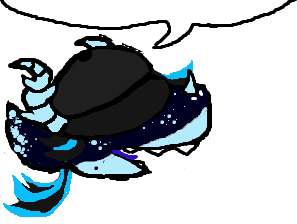
#Shit Terry Says#We always seem to attract a certain type of attention when posting about the IW#If we posted half the stuff that goes on in our system every day on here I think someone's head might explode#Because god forbid we try to make the semi-conscious state we're in while Not Fronting a good time#Also for anyone who's wondering - Canela (the cat) is doing amazing and she's already starting to re-gain the weight she lost
5 notes
·
View notes
Text
Theres nothing good that could come of me reblogging and adding onto the post i just saw so im gonna make a post about it
I think the problem is that this was a vent post that people were taking a discourse post, but OP’s goal wasnt nuanced discussion, it was to vent, so they took it as a threat and lashed out at any replies trying to have a discussion
The post was basically saying that it isnt fair that the rest of the world is under the authority of another government they dont even get to elect (the usa), which is absolutely true
A couple usamericans tried to say what im saying now but got about as misinterpreted as possible, i think. Because, again, responses were not welcome on this post. They werent trying to make everything about themselves, but were trying to defend themselves on a post attacking them personally. The post was already about usamerians, they didnt derail. They weren’t defending their government on a post attacking their government, they were defending themselves on a post attacking themselves
Because for some reason OP made this about american people rather than the american government
They (the americans) said “whos forcing you to care?”, that wasnt taken well, they ARE being forced to care, by the government. But i think what they were trying to say, what im trying to say, is that this is an institutional problem, not a personal problem. They werent whining about how much life in america is so much harder than it is in all the places that our government destroyed, they were trying to illustrate that we as people are doing everything we can to fix our government, for our own and the rest of the world’s sakes, not that we’re too busy with our own stupid american problems to care about all the genocides america is committing elsewhere, but that we know that us simply “caring” about whats going on isnt going to change it, what will change their situation is changing our own government, but just because we’re all doing as much as we can to make that happen doesnt mean we can just simply rebuild our country from scratch because we want to, it isnt that easy
What they were trying to say was that we’re in a similar boat of being oppressed by our government, youre punching laterally at us, not up. Not trying to make it about themselves, not trying to absolve their government, but just not being sure why this is being aimed at them as, ya know, not the government
It’d be like if during ww2 instead of saying “nazis are evil and deserve to die” or “hitler is evil and deserves to die”, you said “all german citizens are evil and deserve to die” - its understandable as a vent, but it just isnt true. And then you get a bunch of germans on your post like “actually we hate what’s going on and we’re really trying hard to change it” and you respond like “im gonna kill a german just because you said that, you really cant stop making it all about yourselves, huh? This is why i hate germans”
I just dont think its helpful to make sweeping generalizations that everyone of a certain nationality is evil, one because thats just a shitty thing to do in general (not as shitty as everything our government is doing, obviously, but again, at us people youre punching laterally. We could play the oppression olympics and make a detailed ranking of exactly which types of people in which countries have it the worst, and yeah probably no american is gonna be at the very bottom of that list, but i dont think that list *matters*, youre dead whether you drown in an inch of water or 10 feet, whether you were simply unsheltered or a nuclear bomb dropped on your town. We need to be on the same team), but also… how do i explain this… its disheartening, as americans, who have at least a little more power to change our own government than people elsewhere do, to be told youre evil no matter what. Theres no point in voting, theres no point in calling reps, theres no point in signing petitions, theres no point going to protests, even running for office, etc, those things have no effect on the fact that youre evil and youre part of the problem. Theres no such thing as a good action, there isnt even a neutral action, everything you can do is evil, because youre an american, so quit trying, by trying youre just making it even more about yourselves. And god forbid you participate in any sort of mutual aid to keep another american from dying, those resources could be used to keep someone good from dying
This is bad, yeah?
#i have a feeling im about to get ‘piss on the poor’ed#its quite likely im being too optimistic about the intentions of the other american commenters#but at least this is what i wish i could say#lilac posts#tw us politics#im not saying theres no shitty americans out there#obviously there is#but this wasnt about that
3 notes
·
View notes
Text
Freelancer vs. Agency vs. DIY: Which Graphic Design Option Is Best?
Whether you’re building a brand from scratch or revamping your marketing assets, one question always comes up—who should handle the design work? Should you hire a freelancer? Sign up with a design agency? Or go the do-it-yourself (DIY) route with online tools?
Each option has its pros and cons depending on your goals, budget, and timeline. But choosing the wrong one can lead to inconsistent branding, wasted time, or even costly redesigns down the road. That’s why more and more businesses are opting for professional, reliable Graphic Designing Services that balance creativity, scalability, and brand consistency.
Let’s break down the three most common routes—and help you figure out which one fits your needs best.
1. Freelancers: Flexible, Affordable, but Risky
Pros:
Budget-friendly: Freelancers are often cheaper than agencies.
Quick turnarounds: Ideal for one-off projects like a logo, brochure, or social media post.
Flexible hours: Many work on weekends and evenings.
Cons:
Varying skill levels: Quality is inconsistent; portfolios don’t always reflect real-world performance.
Limited capacity: One person means bandwidth issues for large or fast-moving projects.
Dependency on individuals: If your freelancer disappears mid-project or is unavailable, your timeline suffers.
No built-in quality control: Revisions can be endless if communication isn’t crystal clear.
Best for:
Startups or solopreneurs with tight budgets and basic, low-volume design needs.
2. Agencies: Scalable, Strategic, and Reliable
Pros:
Team-based approach: Multiple experts (designers, strategists, illustrators) work together.
Brand consistency: Agencies build style guides, templates, and systems to keep your visual identity unified.
Strategic thinking: Good agencies bring creative direction aligned with business goals.
Project management included: No chasing updates or revisions—everything is handled professionally.
Cons:
Higher cost: Agencies charge more due to overhead, team, and scope.
Longer onboarding: More time may be needed upfront to get aligned.
May feel less personal: Communication can sometimes pass through multiple layers.
Best for:
Growing businesses, funded startups, and established brands that need consistent, strategic design support across multiple platforms.
3. DIY Tools: Fast and Cheap—But at What Cost?
Pros:
Free or low-cost tools: Canva, Adobe Express, and others offer thousands of templates.
Full control: No waiting for a designer—you do everything at your own pace.
Accessible to beginners: Drag-and-drop interfaces make design easy to learn.
Cons:
Generic visuals: Your brand might look like everyone else’s.
Time-consuming: Learning design basics takes time—and even more to do it well.
Limited creativity: Templates can’t replace trained design thinking or brand storytelling.
Inconsistent branding: With no central design system, visuals often lack cohesion.
Best for:
Bootstrapped entrepreneurs or early-stage content creators who need simple visuals fast.
Which Option Is Right for You?
Here’s a quick rule of thumb:
Choose a freelancer if you have a specific, short-term design task and don’t need long-term brand alignment.
Go DIY if you’re just testing the waters or working with a tiny budget.
Go with a design agency if you’re looking to scale, maintain visual consistency, and elevate your brand across platforms.
But increasingly, hybrid models—like subscription-based design services or dedicated agency support—are giving businesses the best of both worlds. These services offer the flexibility of freelancers with the professionalism and consistency of an agency.
Conclusion: Your Brand Deserves More Than a Quick Fix
No matter how small or new your business is, your design speaks volumes. It’s the first impression people get of your brand—and often the one they remember. Choosing the right design partner isn’t just about saving money or time. It’s about building something lasting.
So, whether you’re done with DIY fatigue, juggling unreliable freelancers, or ready to scale confidently, explore the value of professional Graphic Designing Services that blend strategy, creativity, and consistency.
Because great design isn’t a cost—it’s a growth tool.
0 notes
Text
Shopify Custom Theme Development: Building a Unique Store Design

Shopify Custom Theme Development
A beautiful website that is easy to use is important for any eCommerce business. Custom theme development on Shopify allows a store to set its own brands and personalized themes that fit within its own brand identity. One can bring different shopping experiences, conversions, and completely own the competition with a new theme.
Why Create a Custom Theme in Shopify?
Shutterstock sells hundreds of standard themes, but these are not always really suited to your business requirements. A custom theme gives you a lot of freedom in design and function. Here's the real deal on which you'd invest your money on custom Shopify themes:
Brand Identity – Build a design that showcases personality.
Better User Experience – Simple navigation.
Tailor-Made Features & Functionally – Integrate your unique features that improve store performance.
Better SEO Capability – Fine-tune the theme structure for higher search rankings.
Responsive Design – Ensure seamless functioning across devices.
Highlight Features of Custom Shopify Theme
Along with looking good, a custom Shopify theme would also have practical usability. Some of the salient features are:
1. Responsive Design
A theme making the site mobile-friendly lets the experience be as similar as possible across all devices.
For Google, such sites get better rankings in search engines.
2. Custom Front Page Design
A page that shows off the best-selling promotions and items to grace the first page.
Updating the dynamic content with information that could interest users.
3. Extensive Filtering
Let customers easily find what they are looking for using advanced filter options.
Include filters for price, category, size, etc.
4. Fast speed
This makes the site good at minimizing bounce rates and enabling better user satisfaction.
Optimize images and code to ensure minimized loading time.
5. SEO Optimized Construction
Clean code with optimized meta tags to enhance search engine rankings.
Schema markup for better visibility is implemented.
6. Customized Checkout Process
Cart abandonment is reduced by customizing the flow of checkout.
Outlining different payment and shipping options.
How to Develop a Custom Shopify Theme
There are essential steps needed to accomplish the process of developing the custom Shopify theme. These are the steps in detail:
Step 1: Define Your Requirement
Now, find out business goals that target audiences and intended features. Draft design elements, as well as functionalities, required for your store.
Step 2: Choose Base Theme or Start from Scratch.
Of course, you may also take a base theme which you would want to modify or develop a theme from scratch. A base theme saves a lot of productive time, while starting from the scratch gives full control over the code and everything.
Step 3: Design Mockups and Wireframes
Mockups and wireframes help illustrate website design and functionality. Aligning that with the vision of the brand on what the final design to be is going to look like.
Step 4: Theme Development and Customization
This is where the Shopify developer codes the theme using Liquid, HTML, CSS, and JavaScript, and then customize the theme. Coding, as well as integration of features.
Step 5: Optimize for Performance and SEO
Optimizing this theme for speed and search engine rankings. Minify code, optimize images, and implement best practices in SEO.
Step 6: Test and Launch
Test the theme exhaustively for compatibility, speed, and functionality. Deploy the theme to your live store following successful testing.
Benefits of hiring Shopify custom theme developer
Although the Shopify conventionally features an easy interface, the need for a developer ensures that the custom theme developed meets industry standards. These are some of the advantages of hiring a professional:
Technical Expertise - Developers have experience in Liquid, CSS, and JavaScript.
Time-saving: Let the activities of the business catch up with you while a developer pays attention to the technical aspects.
Enhanced Functionality: Use advanced features beyond the average to make your user experience better.
Ongoing Support & Maintenance - Keeps you updated with bug fixes and upgrades for better performance.
Best Practices for Shopify Custom Theme Development
Follow these best practices for your custom theme to succeed:
Keep Design Clean and User-Friendly - Create a design that looks simple yet sophisticated and easy to use so that users experience its ease of navigation rather than clutter.
Test Across Multiple Devices - the Testing should include a few most common devices-desktop, tablet, and smartphone.
Not Just Image but Code - Images and code should be well optimized and compressed, as well as minified, for a faster loading time.
Best Practices of SEO - Use relevant keywords, meta tags, and alt texts for better performance in search engine rankings.
There are several problems or challenges related to the development of a custom theme, but if these principles are followed, a much lighter path is ensured: The general Compatibility of Cross Browsers – Make sure that the theme can be tested by different browsers very well. Speed Maintenance and Performance-Performance should continually be optimized and monitored with the theme. Security Threats-You must follow the security best practices to safeguard your customer data.
Custom Theme Development in Shopify is the way forward in building a completely unique and exciting online store. A custom theme compliments brand identity, in addition to improving the user experience and presenting features tailored to achieve conversions and drive sales. With an expert Shopify developer, you can expect a world-class theme that resonates with your business goals and keeps the store performing optimally.
0 notes
Text
[Plain text:
Help Hana and Youssef
[5 wilted flower emojis]
I'm a mother of a 2-year-old child. His name is yousef...I see my son growing up in front of me and I do not know how or when. This is not what I wished for him. I was dreaming of a wonderful life to spend with him...a life not full of death, fear, destruction and deprivation...I wanted to fill his room with toys and his closet with clothes, and I wanted to buy children's books for him, but I couldn't... the war came and the wishes were gone...my goal became to provide him with milk and food. I can barely afford anything. Everything is expensive and we no longer have income to enable us to buy his needs. Kram eggs have been deprived of many of his basic needs. He has been deprived of safety and stability..No, fruits, or meat.
There is nothing but fear that fills my son's eyes as soon as he hears the voices around him. He does not realize what It happens outside, but he feels and sees it in our eyes when he looks at us.I cannot protect myself and my son. Help me to save my son yousef. He deserves a better life, as do all the children of Gaza and the world.
Alone, I cannot, but with your help, we will be able to find a safe place and a better future for my son. Be a reason to change a child's life for the better by visiting our link on GoFundMe. And donate anything to us, no matter how small...every dollar makes a difference and give a life for my son..
I am Youssef. I was very young at the beginning of the war, but now l have grown up and can walk and know how to speak and understand everything. I hope to get your help in publishing or donating on our Aaljo Fund Me account
[ID: A collage of 9 photos:
A selfie of Hana.
A building with rubble covering the ground in front of it.
Cloths hung up to form a tent. Rubble from a destroyed building.
The inside of a cafe, with tables with umbrellas over them. The photo taken from one of the tables.
Yousef.
Drinks and dessert on a table at the cafe.
A partially destroyed building.
The remains of a destroyed building, with almost nothing left. End ID.]
My campaign is verified by 90ghost. verified campaign is listed as number 246 on the verified fundraiser spreadsheet vetted by nabulsi and el-shab-hussein
5€ may seem small
The most difficult decision for us was to leave our country, to leave Gaza, overcome the obstacles we faced and the losses we suffered, and begin a new life from scratch.
End plain text.]
[ID: A graphic reading:
Do you feel helpless?
Here is one simple thing you can do
End of text. Beneath the text there is an illustration of a slice of watermelon. To the right of it is a photo of Hana taking a selfie while holding Yousef. There is a border around them shaped like Palestine. More text reads:
To my child. My heart really needed you. I will love and protect you with everything I have. And you will never have to face anything in this crazy world alone. I've got you.
End of text. To the right is a photo of Yousef. Text at the bottom of the image reads:
But this time I need your help beautiful people. Please donate even £10 makes a difference for us
End ID.]
Previous GoFundMe campaign shared by 90-ghost
The update on the GoFundMe page links to the new Chuffed campaign, asking for donations to be sent there instead. Check the above link for proof.
Help Hana and Youssef
🥀🥀🥀🥀🥀
I'm a mother of a 2-year-old child. His name is yousef...I see my son growing up in front of me and I do not know how or when. This is not what I wished for him. I was dreaming of a wonderful life to spend with him...a life not full of death, fear, destruction and deprivation...I wanted to fill his room with toys and his closet with clothes, and I wanted to buy children's books for him, but I couldn't... the war came and the wishes were gone...my goal became to provide him with milk and food. I can barely afford anything. Everything is expensive and we no longer have income to enable us to buy his needs. Kram eggs have been deprived of many of his basic needs. He has been deprived of safety and stability..No, fruits, or meat.
There is nothing but fear that fills my son's eyes as soon as he hears the voices around him. He does not realize what It happens outside, but he feels and sees it in our eyes when he looks at us.I cannot protect myself and my son. Help me to save my son yousef. He deserves a better life, as do all the children of Gaza and the world.
Alone, I cannot, but with your help, we will be able to find a safe place and a better future for my son. Be a reason to change a child's life for the better by visiting our link on GoFundMe. And donate anything to us, no matter how small...every dollar makes a difference and give a life for my son..
I am Youssef. I was very young at the beginning of the war, but now l have grown up and can walk and know how to speak and understand everything. I hope to get your help in publishing or donating on our Aaljo Fund Me account
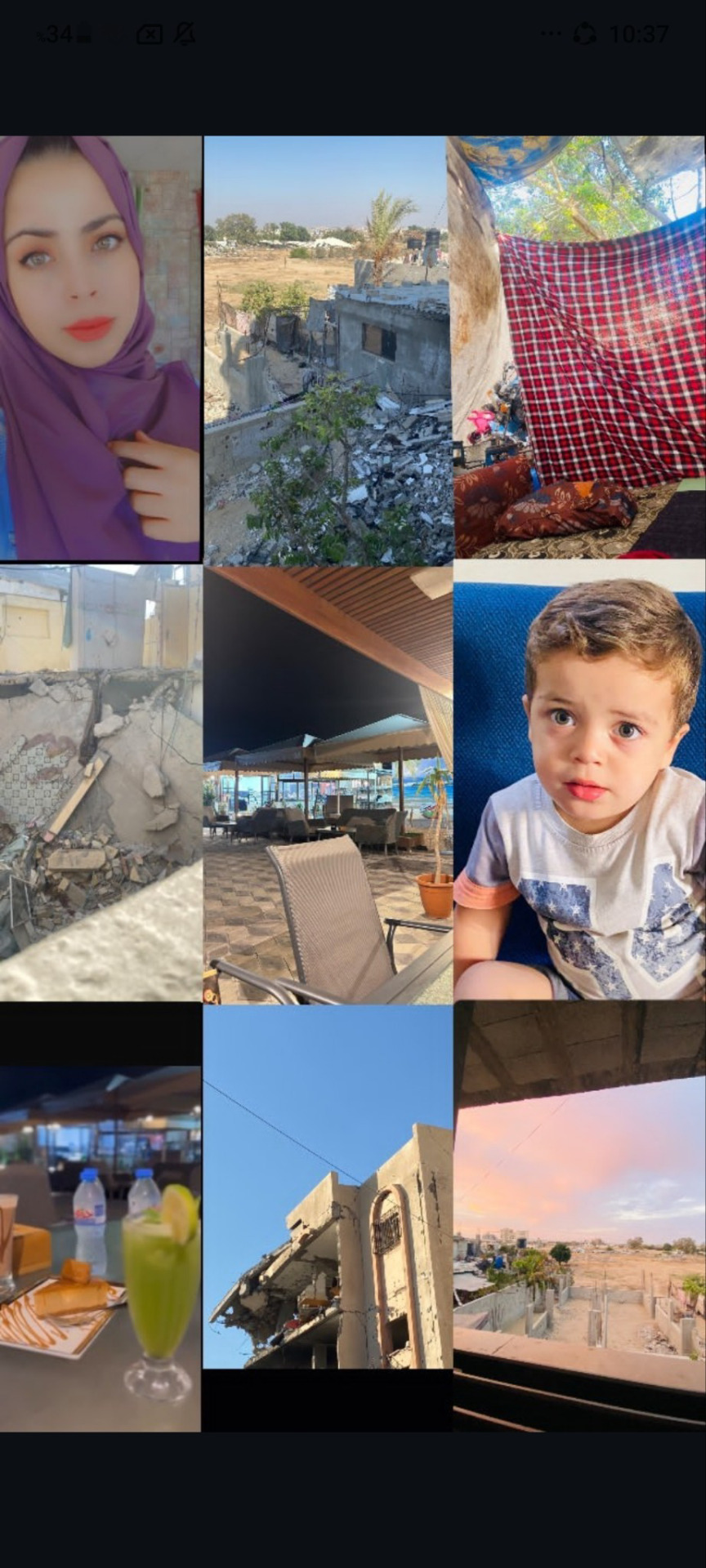
My campaign is verified by 90ghost. verified campaign is listed as number 246 on the verified fundraiser spreadsheet vetted by nabulsi and el-shab-hussein
5€ may seem small
The most difficult decision for us was to leave our country, to leave Gaza, overcome the obstacles we faced and the losses we suffered, and begin a new life from scratch.

6K notes
·
View notes
Text
Thinking about quitting art
With the tiktok ban, I will be losing my biggest platform, and I will have to once again start from scratch. I am so close to reaching 1000 followers. I was so happy with what I was making, but now it feels like everything I have made since the beginning has been completely pointless.
I don't want to work on my comic. I want to make my skits, but they go off into the void and no one sees them. I lose the only support I get, and my illustrations are eaten alive by AI.
At this point, art feels like such a waste of time when I could be doing other things that I enjoy as well, like crocheting, video games, writing, playing music, witchcraft, or anything out in nature. I had chosen art to be my primary goal in life and when I finally felt like it was starting to pay off, my support is ripped away from me yet again and I am sitting at a sub-100 following on every other platform besides youtube...What was the point? Is there any point at all? You can say making it was the point, but I feel no joy when there's no one to share what I made with.
I think...I hate making art now.
0 notes
Text
Tube Mastery and Monetization by Matt Par
*Introduction:** In the digital age, the power of video content cannot be underestimated. YouTube, with its staggering user base and diverse content, has become a platform where dreams can come true. Whether you’re an aspiring content creator or a business looking to expand your reach, YouTube offers incredible opportunities. But with great potential comes great competition. To navigate the YouTube landscape successfully, you need the right guidance, and that’s where **Tube Mastery and Monetization by Matt Par** comes into play.
**Chapter 1: Who is Matt Par?** Before diving into the course itself, let’s get to know the man behind it. Matt Par is a prominent figure in the YouTube space, known for his expertise in creating and monetizing YouTube channels. With his impressive track record, he’s the perfect mentor to guide you through your YouTube journey.
**Chapter 2: Inside Tube Mastery and Monetization** Tube Mastery and Monetization is a comprehensive online course designed to help you master YouTube, whether you’re a beginner or looking to take your channel to the next level. Here’s what you can expect from this course:
**2.1 In-Depth Content:** Matt Par leaves no stone unturned. The course covers everything from niche selection, video creation, channel optimization, and growth strategies. You’ll learn how to build a channel that stands out.
**2.2 Monetization Strategies:** Earning money on YouTube is a goal for many, and Matt Par provides insights into various monetization techniques, including ad revenue, affiliate marketing, and product sales.
**2.3 Case Studies:** The course includes real-world case studies that illustrate how Matt Par has successfully implemented the strategies he teaches. These examples provide invaluable insights into what works and what doesn’t on YouTube.
**Chapter 3: Why Choose Tube Mastery and Monetization?** There are countless YouTube courses available, but what sets Tube Mastery and Monetization apart?
**3.1 Proven Success:** Matt Par has built multiple successful YouTube channels, and he shares his personal experiences and strategies in this course. You’re learning from someone who’s walked the walk.
**3.2 Comprehensive Guidance:** This course is suitable for both beginners and experienced YouTubers. Whether you’re starting from scratch or trying to revitalize an existing channel, you’ll find valuable information.
**3.3 Ongoing Updates:** YouTube’s algorithms and trends change over time. Matt Par ensures that the course content is regularly updated to keep you ahead of the curve.
**Chapter 4: Student Success Stories** To inspire and motivate, Tube Mastery and Monetization showcases success stories from students who’ve benefited from the course. These testimonials serve as a testament to the effectiveness of the strategies taught.
**Chapter 5: Is Tube Mastery and Monetization Right for You?** Before investing in this course, consider your goals, commitment, and passion for YouTube. If you’re serious about building a successful channel and are willing to put in the effort, this course is a valuable resource.
**Conclusion:** YouTube is a platform filled with potential, but realizing that potential requires knowledge and guidance. Tube Mastery and Monetization by Matt Par offers a comprehensive, proven roadmap to YouTube success. Whether you’re looking to create a new channel or optimize an existing one, this course equips you with the skills and strategies needed to thrive in the world of YouTube content creation.
Don’t miss out on this opportunity to learn from one of YouTube’s best. Unlock your YouTube success with Tube Mastery and Monetization today.
BUY THIS PRODUCT THROUGH THIS LINK :https://www.digistore24.com/redir/299134/FilsterSetiawan/
1 note
·
View note
Text
Writing Your First TTRPG
So you want to write your first TTRPG system.
A short thread.
First, you should know that you don't have to make your TTRPG from scratch.
You can always use Mork Borg or Fate or PbtA or Trophy or any other system that supports third party content.
Systems like Caltrop Core even come with tutorial material for how to write your game.
But let's say you don't want any guardrails. You want to make the whole thing yourself. Here's how to do that.
To start, zero in on what your system's about.
Don't worry about genre or style, just find something you think would be fun to tell stories about. Dinosaur bikers. Astronauts in a lover's tiff. Spiders selling hats. Anything.
Now that you've got your subject, the next step is crucial.
Dive right in.
I'm serious. Open up a document and start writing the part of the game that is most interesting to you.
It might be character Classes, or monsters, or even just a basic idea of how you want your game to handle some part of gameplay.
"Food is important! There's rules for hunting!" is a fine place to start.
From there, build outward.
If you've written "Gremlin Class: +1 to Sneak, +1 to Airship Repair", that tells you two things about how your system works.
It tells you that both sneaking and airships matter in your game, and that you should write rules for them.
When writing rules, here are some things not to worry about just yet:
-Are the rules realistic?
-Do the rules work?
Just get some mechanics down. Give people a way to interact with your game.
"Roll a d6. High is good and low is bad" is a fine place to start, but you can get weirder.
Do you want people to roll a lot of dice? Or use dice that get neglected?
Do you want to test something other than dice rolling, like playing cards or flicking a paper football?
Do you want players to have some degree of control over the dice? Can they spend a resource for rerolls, or to simply succeed?
You might end up finding that your dice system works a bit like another game, and this is completely fine. There are thousands of TTRPG systems that have elements that overlap with each other. Nobody has a patent on target numbers.
Once you've got some mechanics, take a look at how they interact with the other thing you built---the thing you care about. This will inspire you to design further.
Add new Classes, new monsters, new subsystems.
Keep designing until you feel like you've written down everything you want to, and then get some sleep.
Yes, really. Put the project down, go to bed, wake up the next day, and edit it.
Your game is going to look incoherent at first, and that's fine. The goal of this editing pass isn't to get it perfect. It's to get your game to the point where someone can read it and make a character.
Once your game is in that state, get some friends to build PCs. Play a session. See what breaks. Go back and adjust your game to fix the things that broke. Then play a bit more. See what else breaks.
If you wrote a really big system, this will all take longer, but eventually you'll find that your system isn't breaking all the time.
At this point, you can keep it for yourself and your friends, or you can distribute it.
Platforms like itchio are great for posting new TTRPGs. Depending on your skillset, you might illustrate your game and put it through layout, or you might just export it as a PDF and post it. Both approaches are fine.
If you decide you want to make your project into a commercial undertaking, you can go to kickstarter or gamefound, or print zines and sell them yourself. Or you can just sit back and enjoy the thing you've made.
--
Coda: This is absolutely not the only way to design TTRPGs, and I'm sure a lot of designers have completely different processes. If this approach isn't working for you, or if there's something you hate about it, go with your instinct and do things different.
341 notes
·
View notes
Note
Hola capaa~~ argentina y entusiasta de Clamp, JJK y Sonny Boy sos todo❣️❣️
I absolutely love all your psych analysis!! I was wondering if you’d like to write a little about Gojo’s relationship with Megumi, like what he views him as. I know there’s a lot of discourse about whether megumi views him as a father/brother/uncle/mentor/guardián but I’d like to read about Gojo’s probable view.
Saludos de CABA❤️
Hola hola! Mucho gusto ♥!
Dear CABAnon... I just need you to know that your ask is an amazing question that required so much fun and multilayered brainrot.
So thank you for the ask and thank you so much for your kind comments. I will write in English in case anyone else wants to read this word vomit but will say hello in Español at the end of this post.
I'm also so glad you're a CLAMP enthusiast too because I'm going to drop clamptastic moments to illustrate points. My heart rejoices in knowing you'll get it.
So without further ado...
Gojo + Megumi. Let's brainrot...
Also... I may or may not have written a whole analysis post only to realize that I wasn't necessarily answering your question so I ended up deleting most of what I had written.
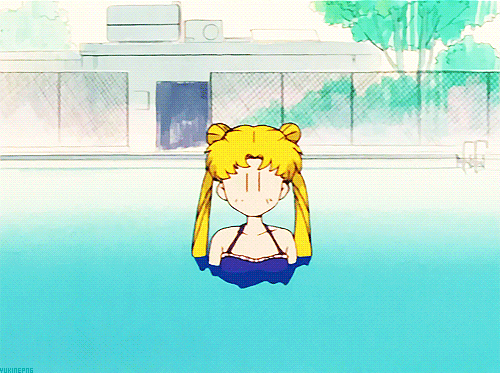
Hence the delay...
Ok procrastination, attention deficit disorder, and my overall slow temperament might have had something to do with it too. So thank you as well for your patience! 😂
ANY-WAYS!
I've written about my thoughts on this relationship from Megumi's perspective in the past, but I feel like my thoughts could use some more nuance given everything we've seen of this dynamic as of late.
What I'll start by saying is that Gojo isn't a character I spend a lot of time brain rotting about, so I may only scratch the surface of my interpretation of him, or perhaps even mischaracterize him a bit *gasp*.
That to say that in order to answer your question, we kind of have to peel back the layers of this dynamic.
So let's start by taking an in-depth look at Gojo:
Gojo Satoru is human af
Ok so... names have meaning in JJK, right?
So given how popular he is in the JJK-fandom, I am assuming it is common knowledge that his name, and the kanji in his name, alludes to an enlightened being.
In other words, Gojo is a bodhisattva--an enlightened being who is able to enter Nirvana but delays doing so out of compassion for others and their suffering.
But here's the thing...
“One does not become enlightened by imagining figures of light, but by making the darkness conscious.”
Carl Jung
What is interesting about Gojo is that, despite his exalted spiritual status as the personification of a bodhisattva, he is actually VERY human.
For one, in relational dynamic to others he keeps others at a safe distance. Like that's literally part of how his Cursed Technique manifests, which is a beautiful example of how Cursed Technique can be a metaphor for the sense of self.
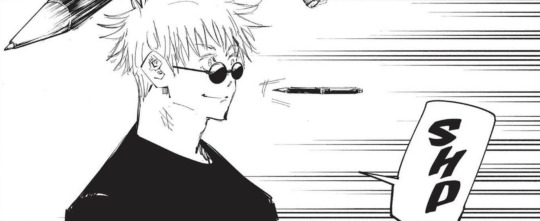
Second, Gojo CARES SO MUCH AND SO DEEPLY, it is actually shown how his emotional entanglements are one of his main weaknesses.
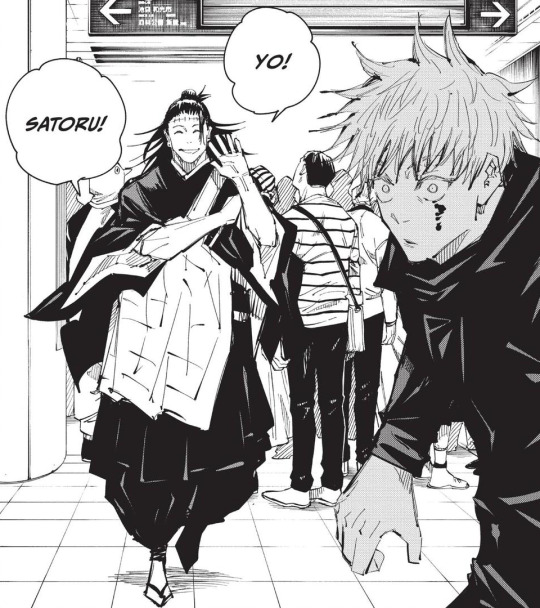
Now, for context, consider that emotional entanglements are a form of self-related attachment and that, in very simple terms, the goal of enlightenment is to transcend attachments that might hold the sense of self back from Nirvana.
Third, Gojo is a direct product of the society he is a part of since he does carry the burden of The Strongest / The Chosen One.
It's almost like Gojo's clown externalized persona is an attempt to add some much needed comic relief to the self-definition others have given him. An attempt to lessen the heavy burden of what it means for others to think of him and define him as The Strongest.
Now, what does strength/power mean in JJK? Overwhelming sense of self which is the byproduct of self-knowledge.
So I headcanon that it is precisely because he knows he is The Strongest, that, true to his character archetype as a bodhisattva, Gojo seeks to alleviate the suffering of others. Thus, his actions in an attempt to alleviate suffering are the result of his nature.
And here's the fun twist: Gojo seeks to do so through "power".
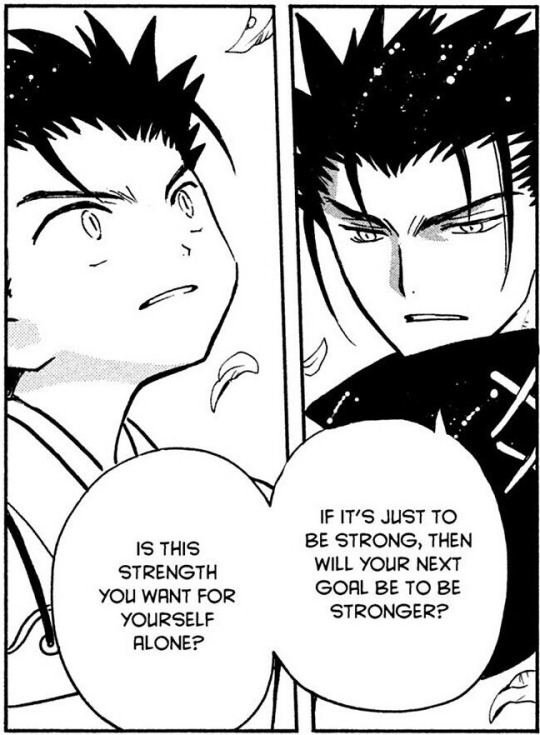

Now let's add Megumi to the mix.
Issai shujo to tomo ni
To answer your question, in addition to understanding Gojo's nature as a compassionate being driven by his attachment to others, we have to consider his actions and motivations.
Gojo bringing Megumi under his wing is an interesting rabbit hole for many reasons.
So let's start with the idea behind the theme issai shujo to tomo ni (“together with all sentient beings”—regardless of what hell one might fall into).
Consider that "it’s not enough for a bodhisattva of the Mahayana to just uphold the precepts. There are times when you have to break them, too. It’s just that when you do, you have to do so with the resolve of also being willing to accept whatever consequences might follow" (source).
To put it in JJK-words, how is Gojo abusing his position of power to further his own agenda?
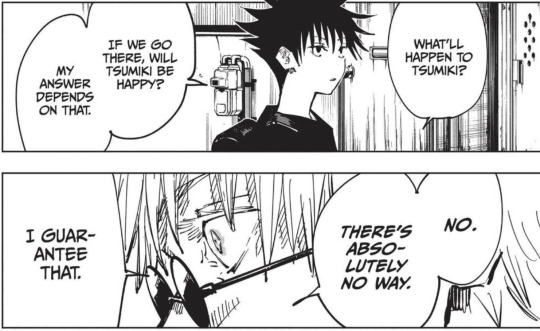
Basically, it's a major red flag in terms of how Gojo might initially see Megumi as a means to pushing his own agenda for seeking power in order to fulfill his function as bodhisattva.
It's just that Gojo, as the adult in the dynamic, consciously and willingly manipulated Megumi into something that was beneficial for the both of them.
In other words, this is a red flag because Gojo, the adult, acted like a child and gave Megumi, the child, an adult choice.
This might loosely remind you of this fantastic meme and the context behind it:
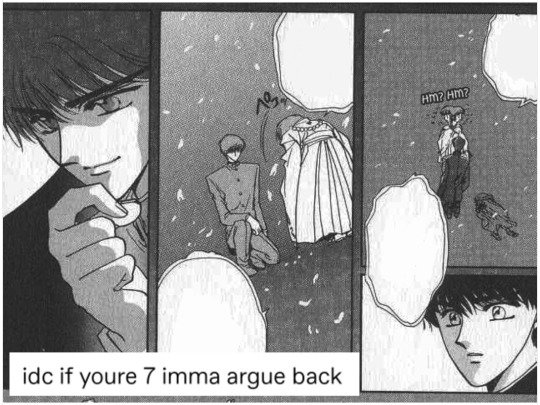
(Source: noa-ciharu's fantastic talent for shitposting).
I just wanted to use the meme because it's about someone taking advantage of someone else's lack of psychological maturity.
As a side note, this also made me realize just how much JJK is exploring the idea that people's vulnerabilities get exploited by those who are in positions of power.

The thing is that Gojo could have just as easily ignored Megumi or reported him to the authorities. But he didn't do that, did he?
Instead he took Megumi under his wing and groomed him to become a tool that could help him change the Jujutsu-scheme of things. You could look at this and think "that's awful!" and you can also look at this and think "yes, it's shady, AND Gojo was also looking to help Megumi maximize his highest destiny and potential." More on this in a bit.
This is relevant because it says a lot about Gojo's "humanity" and the lengths he will go to for the sake of his goal and desire to alleviate the suffering of others.
Again, Gojo gave Megumi a choice Megumi should not have had to make. I have a 9 year old nephew, so I'm all for giving children choices so that they can develop their own sense of self. But the choices have to be age appropriate.
In other words, the adult in the room, Gojo, anticipated and used Megumi's innocence and love for Tsumiki as leverage to manipulate a specific response from Megumi that would benefit the both of them.
Which brings us to the next layer...
Noblesse Oblige
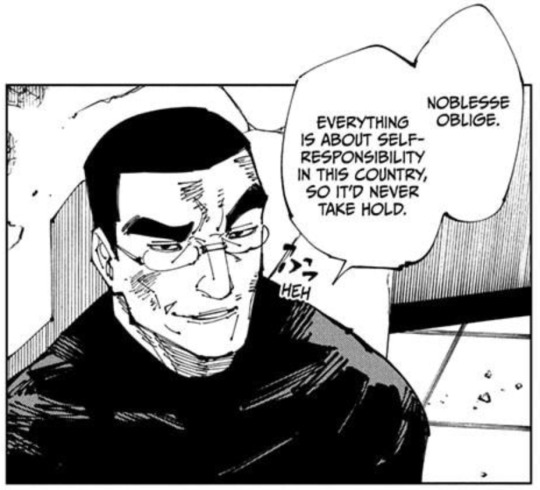
I think that because I come from a last name De los Reyes, I LOVE and deeply resonate with this term.
It's so...
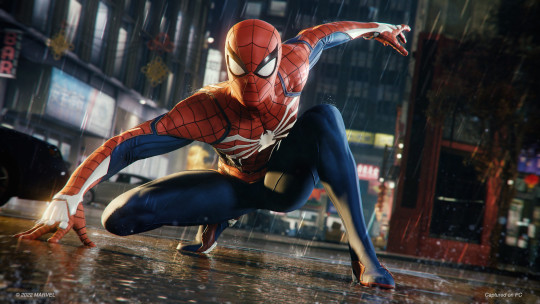
"With great power comes great responsibility."
Voltaire
This is where the rabbit hole gets fun because, were it not for Toji's last words to Gojo, Megumi and Gojo might have never crossed paths.
And is there anything more clamptastic than the idea that inevitable emotional entanglements are the result of fate bringing people together?
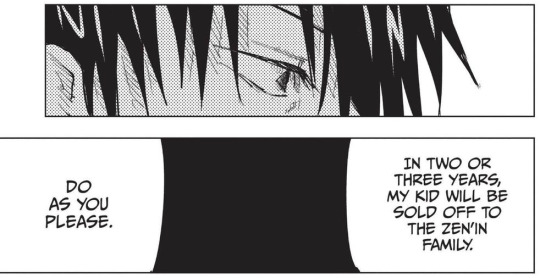
The question this brings up for me is... even though Toji gave Gojo the choice (here we have choice as a theme again) to do as he pleased, can we consider this to be a curse that Toji put on Gojo seeing as these were his last words to him?
So the fact that Gojo chose to follow through with Toji's last words is the stuff of tragedy given we've already seen that Gojo's weakness are his emotional entanglement to others. And now that Sukuna has taken over Megumi's body... well... should we brace for tragedy?
But I digress...
The point of this layer is to introduce the idea that perhaps Gojo is someone who fosters strength / power in others through self-knowledge, both for the sake of his own agenda, and also because of the idea behind noblesse oblige--with great power comes great responsibility.
In other words, consider Megumi's theme in the sense that it would have been a complete waste of the talent he was born with, the prized family jewel worthy of one chosen by fate, to be squandered away in a lifetime spent fighting bullies.
Did Gojo see Megumi's worth only in terms of his family's name and his Cursed Technique? I think initially that might have been the case.
There's definitively something to be said about how Jujutsu society as a whole is a microcosm for the toxic Capitalist zeitgeist that permeates our world where our worth is measured against what we can do rather than for the mere fact that we are alive.
But... that's the thing, even if Gojo, as a product of his environment who is ironically seeking to upturn the very system that gave him the power that he has... Gojo is still Gojo, and Gojo is human af.
And for someone who is as enlightened as he is...
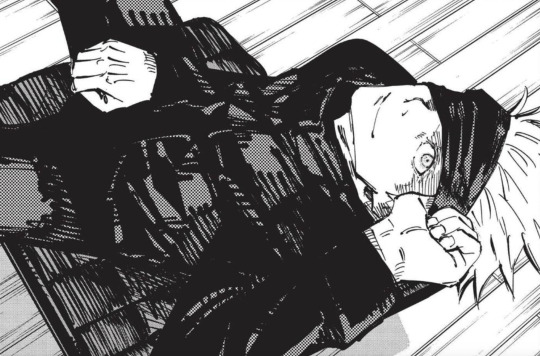
To blind himself to this truth about himself, to keep others at a safe distance in an attempt to lessen those emotional entanglements... well, it is kind of tragic, isn't it?
My precious student
I could have literally written this section only and called it a day but like... where's the fun in not word vomitting?
I have to say that I am loving how Gege is starting to tie loose ends. Promises he made early on in the manga are starting to unfold before our eyes.
For Gojo, the Hidden Inventory arc sets the stage for seeing just how much Gojo cares and the lengths that he will go through to alleviate the suffering of others because of how deeply compassionate he is.
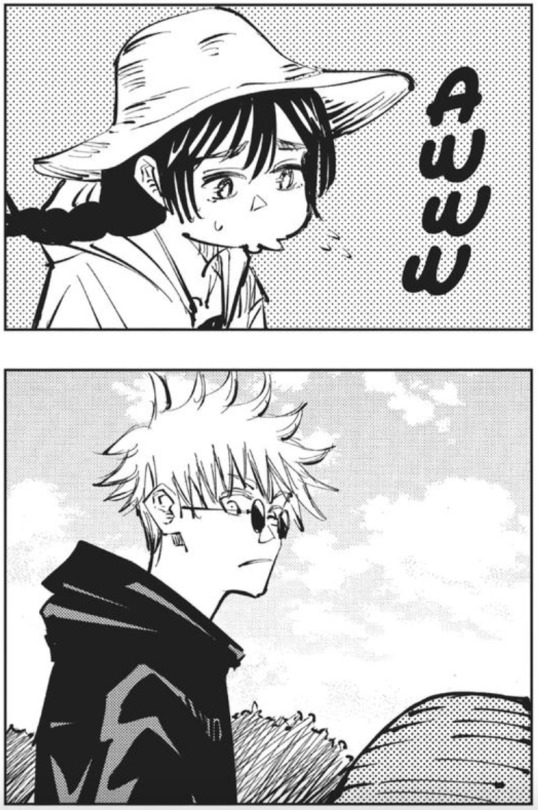
So there is no doubt in my mind that Gojo CARES for Megumi deeply and holds Megumi in high regard both intellectually and emotionally.
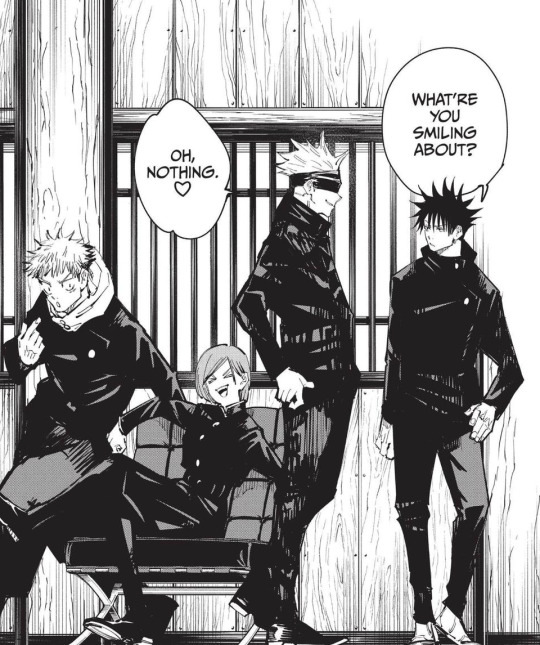
Like... even if the way he recruited Megumi can be considered shady, I personally think it's in Gojo's nature to care deeply.
As a result I personally like the idea that Gojo came to care for, know and understand Megumi deeply. I should probably open a thesaurus to find a synonym for deeply, I've used that word like 5 times already.
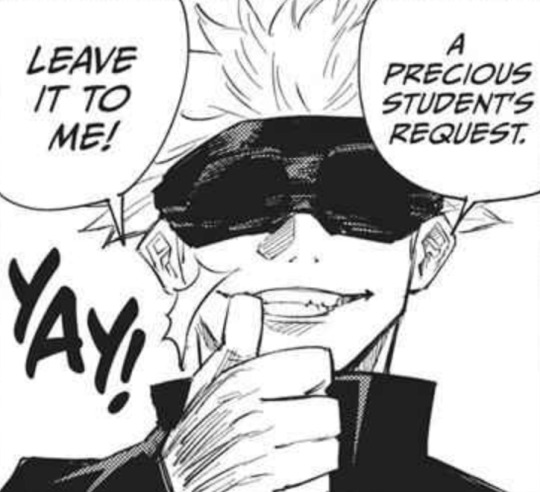
I also think that Gojo sees in Megumi a mirror of himself given their fate has been somewhat defined by their respective Cursed Techniques. There's actually a lot of parallels in their behavior if you look closely.
Now, one of the biggest questions in fandom has been what life was like growing up in the Fushiguro household and what it was like to grow up under Gojo's tutelage.
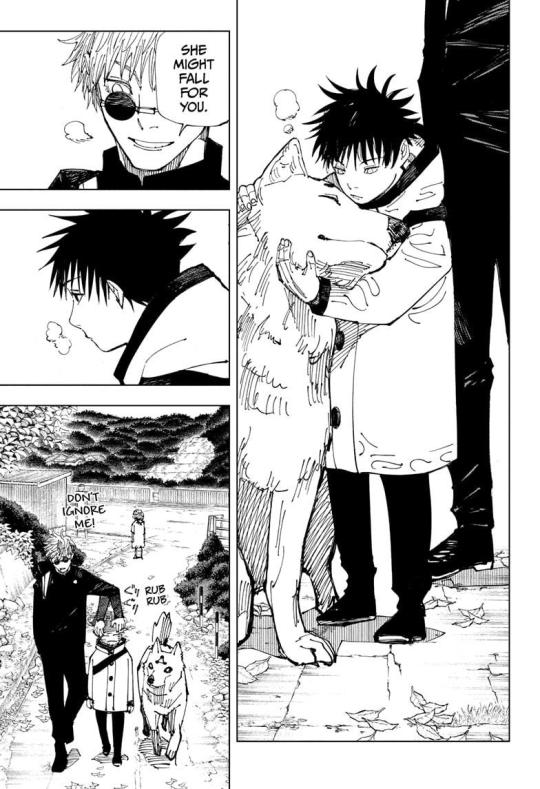
So I love that Gege has finally given us a sneak peek at that dynamic because it sheds light into the answer to your question.
To me the panels above might show how Gojo approached fostering Megumi's talent. I could be wrong, but I get major "let's go for a walk so I can teach you something" vibes.
And like... I can't imagine how Gojo could have possibly avoided getting attached to Megumi if he basically saw him grow up. Whether he was around every day or came and went is the stuff of head canons.
But I definitively think there's a lot of love between these two characters and that Gojo sees Megumi not just as a student whose power he needs to foster through self-knowledge, but also as a protégé that was entrusted to him.
Now... given emotional entanglement is one of Gojo's major weaknesses, it makes me wonder what Gege is going to do once he lets Gojo out of the prison realm.
It makes me wonder what lengths Gojo will go through to alleviate Megumi's suffering.
Spanglish alert!
Merci a ma chérie (@justafrenchlondoner) for being a sounding board to help me answer this loaded question. We both loved the brainrot that ensued because of it.
Finalmente...
EAAAAA! Mucho gusto CABAnon!
Así es! Soy entusiasta de clamp, JJK, y Sonny Boy! Me encanta q t gusten a ti tb! The trifecta of perfection if you ask me. Lo único differente es q soy Mexicana pero al fin de cuenta, esa diferencia importa poco :)
Espero halla podido contestar tu pregunta... jeje... con eso d q me fui por una tangente q ni al caso me tardé un poco mas de lo esperado pero la vdd disfruté mucho contestando tu pregunta.
Espero escuchar de ti y tus pensamientos al respecto d nuevo!
Saludos desde mi pedacito en el Desierto de Chihuahua, victoria la psicoloca.
#ask the mental gymnastics anime girl#god I love jujutsu kaisen#1 out of 3 asks answered#2 more to go!
18 notes
·
View notes
Text
Lessons on conditioning with Jane
Jane looks excited. This is one topic that she almost always enjoys talking about. Among her victims, bringing up topics like this is known to give them a short break as Jane lists out everything she knows.
“You want to learn more about conditioning? Well, you’ve asked the right person. I’m a conditioning expert!
“There are two kinds of conditioning, classical and operant. We’ll talk about classical conditioning first. Classical conditioning is typically what you’ll think of when someone mentions conditioning. It’s the Pavlov’s dogs thing.
“In classical conditioning, the goal is to associate a neutral stimulus with an unconditioned response. So, if your goal is to make dogs salivate at the sound of a bell, the bell is the neutral stimulus and salivating is the unconditioned response. If your goal is to make someone go limp at a certain phrase, the phrase is the neutral stimulus and going limp is the unconditioned response.
“In order to do this, you need to associate the neutral stimulus with an unconditioned stimulus. An unconditioned stimulus is what triggers unconditioned response. Food is the unconditioned stimulus that triggers salivation. And you can use drugs as an unconditioned stimulus to trigger paralysis.
“To associate the neutral stimulus with the unconditioned stimulus, you just need to do them at the same time. You ring a bell at the same time as you feed the dogs. You say the phrase at the same time as you drug your pet. This is the acquisition phase.
“You do that for a while, and then: tada! The dogs will start to salivate at just the sound of the bell. Your pet will go limp at the sound of your phrase. Now, your neutral stimulus is a conditioned stimulus and your unconditioned response is a conditioned response. Congrats!
“Unfortunately, this doesn’t last forever. If you just keep ringing the bell or saying the phrase, the conditioned response starts to wear off. This is called extinction. You need to keep associating the conditioned stimulus with the unconditioned stimulus if you want to maintain the same results.
“If extinction does occur, the conditioned response can come back (weaker) after a period of time. This is called spontaneous recovery. Spontaneous recovery doesn’t last very long, though.
“It’s also easier to recreate the conditioned response after extinction than it is to create a conditioned response from scratch, so don’t lose hope if you find extinction has occurred. The work you put in wasn’t pointless.
“There’s also generalization and discrimination. Generalization in this context is when stimuli similar to the conditioned stimulus triggers the conditioned response. Sounds similar to bells triggering salivation, similar phrases triggering paralysis, etc.
“Discrimination, in this context, is the opposite of that. The organism learning to only have the conditioned response to the conditioned stimulus is discrimination. In this context.
“And really, that’s just the basics! I’d love to talk about various studies that illustrated different things about classical conditioning. And we haven’t gotten to operant conditioning. But I’ve been talking for too long, haven’t I? We should get back to your punishment.”
#jane’s pets#this has been in my drafts for a while so I might as well post it now#It’s much more psychology than character stuff#so feel free to skip#torture mention tw
7 notes
·
View notes
Photo
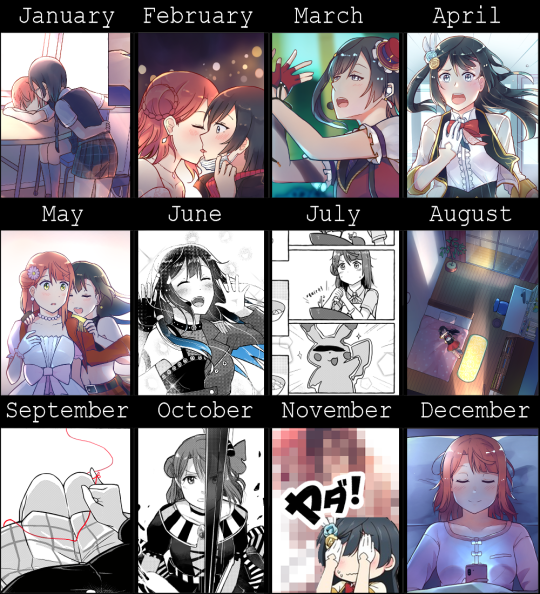
Art Summary: 2021
It’s time for my yearly art review! This makes my 8th year of recording year-long summaries. They’re really piling up now. 😊
I feel like this summary isn't really indicative of my improvement? It's more like what I got up to over the year.
...I really did draw stpm for an entire year 🤣
Previous: 2014 | 2015 | 2016 | 2017 | 2018 | 2019 | 2020
Let’s see... what did I get up to this year?
My worklife shifted to primarily working from home, so I ended up getting more time to draw. Though on the flipside I’ve been quite busy with my life, especially because I’ve been trying to organise building a house with my family. Either way, my comic output has been quite constant.
It may have taken me 2-4 months to do ch8 in my series, but I wasn’t spending that time sitting around y’know. I feel like I’m becoming a lot more confident with making comics like this! I usually feel a lot of grief about how I’m “not fast enough” and things like that. But looking back, I really should cut myself some slack 😅. I did 138 pages worth of comic this year. On average that makes about 11 pages a month. Of course this doesn’t take into account whether those pages were coloured or not, not does it take into account the breaks I’ve taken to do standalone illustrations or other things but I still think it’s pretty consistent work if you ask me! And I’m happy I could keep it up. Comics are the kind of thing you get better at by just doing, after all.
As a side-note, I’m also happy that some of my work was accepted onto Dynasty Scans this year. People have different opinions about rehosting, but for my comics specifically, I feel comfort in knowing that they’re archived somewhere outside of my art accounts. Especially somewhere that people visit specifically to read comics.
Overall... I’m pretty darn satisfied with the content I’ve output this year! My series has always been really fun to do (even though it can be stressful) because it really lets me try to flex all of my muscles, y’know? Painting skills, writing skills, doing weird backgrounds, doing weirder angles... Stuff like that. Just trying new things. Even if it’s hard to do, I have a lot of fun trying to push things further! Of course I’m not a machine and that’s not something I can constantly do, so weaving in black/white one-shots is also very satisfying. I think above everything, I want to be able to tell a good story, so being able to do comics quickly in b/w really helps me quickly pump out an idea!
I wonder if there’s anyone out there thinking “when will she get tired of drawing Setsuna/Ayumu” and honestly that’s a really good question. If you’ve been a long time follower of mine, you probably wouldn’t be asking such a question though, You’d know that I’m that kind of person who draws a single thing and nothing else for years at a time 😂. I’m just very focused okay!! I’m a depth-first kind of person when it comes to things and I still feel like there’s so much to explore between these two. I’m sorry if there’s anyone out there who wants me to draw other ships 😂. It’s just that I really adore these characters, so I wanna continue to explore and develop them! Both as characters and as a relationship dynamic. I feel like I’ve barely scratched the surface honestly... so I have my work cut out for me. (I definitely have no shortage of ideas).
I think that’s it for my general overview? Well it’s what I can think of at the moment. I’m gonna move into where I am and where I wanna go in terms of art.
Like I said before, I’m pretty satisfied with what I’ve been getting up to. Of course, technical-skills-wise I definitely have a long way to go. My lines are still so... tight, I have difficulty drawing in perspective (which really puts a wrench in lining up dramatic panels) and I barely know what 3D-shape is to name a few things. But let’s talk about what I’ve been doing!
Last year I wrote the following goals in my art summary. Let’s address them individually:
“I want to finish my comic series”
Hahhahahahahahah I’m so sorry 2020 me. This comic was a lot bigger than you initially imagine 😂. I’m not going to make any excuses or anything. But I can say for a fact that I will most definitely finish this comic in 2022! I promise!
“I want to continue to play to my strengths and enhance them”
This is a vague-sounding goal, but it still rings true. I know that my skills mainly lie in being able to create atmosphere/tone to best communicate a feeling. At least that’s what I think. But I believe I have been enhancing them! Over the course of my comics this year I’ve been trying lots of new things when it comes to lighting and colour! For my main series comics I actually do quite a bit of research and experimentation. Like in Ch 7 the rainy day scenes took some playing around with. And in ch8 the entire chapter had me trying ~4 different approaches and strategies. I think it’s really important to try to do new things and push out of your comfort-zone so I think this has been valuable to my learning. I feel like I could’ve better explained this bit but... well I’m writing this mainly for myself and I know what I mean sadaskdadklsf
“I also want to continue to try things that are outside of my comfort zone. I want to see myself try things like different angles/perspectives and more complex backgrounds.”
Speaking of comfort zones, I also shared the desires to push from them last year too. I don’t think I really pushed too far, but, I think a little goes a long way y’know? Hmmmm, while I did do more interesting angles and perspectives over the year, I don’t think I pushed as hard as I could. The same with backgrounds. While there is definitely improvement in this areas compared to last year, I think I could do a lot better. But! I will give myself credit where credit is due. It’s actually this year - a few months ago where I started using 3D tools and various other resources to help me draw. I used to be very stubborn against using such things, but now I’m much more open to it. Specifically I’ve started using 3D-models in Clip Studio Paint! This has really helped me visualise different angles and even implement foreshortening where I otherwise would’ve struggled. I feel it has helped with my improvement this year for sure. I’m hoping to better gain and understanding of 3D-space by continuing to use tools to assist me because I seriously have bad intuition for it asdasdasd.
Okay! Moving forward! What do I wanna learn in 2022? Well I have a couple of loose goals:
I want to do more illustrations/quick drawings on top of my comic work.
One thing that I always sulk about is how long my comics take to produce. And at times, it really can’t be helped. Especially if the comic is fully coloured. And like...how do I explain this... I want to upload work as often as any other fan artist, y’know? Whenever I post my big comics I feel the tension of months of work releasing from me, and like, it’s a lot lighter on my mental to be able to work on smaller things and actually finish them. So one thing I’d like to implement is some way to work in smaller works. Whether that’d be little mini comics, or doodles or whatever while I’m working on my bigger comics. How I’ll do this? We’ll see what works, but at the moment I’m thinking of allowing 2-4 hours a week for me to work on whatever I wish outside of the main comic. Like 2 hours twice a week? Or 2 hours a week? Or- well you get the idea, I’ll figure it out! Just some time set for little things so I can get more of my ideas out.
I want to learn to paint.
This isn’t really a compulsory goal, but it’s somethign that would be nice to explore, even if it’s just a bit. For those who aren’t too familiar with making art, I’m referring to a dramatic change in my process. Usually I draw a sketch, ink the lines, and then colour beneath the lines and on top of the sketch. Now when i say “paint” I mean it in terms of process. This would be sketching, plopping base paints on top of the sketch, then colouring as usual, painting in lines as I need them on top (much like traditional painting!). I find the style rather appealing, but it’s a bit hard for me to get used to hahahahah. But if I can figure it out well, it might help contribute to my next goal.
I want to learn to draw faster.
Above everything, I would like to be able to tell the stories that I want to tell. So it’d be helpful if I could output stories at a faster rate. I think my lining is really slow... well I think I’m quite slow in general. Even my drafting is quite slow. There are a two angles I can approach this gripe of mine from.
Faster lines.
Faster/more clever drafting.
As I’ve mentioned my lines are quite tight. If I could learn to be more loose and flowy, then perhaps I’d be able to draw faster.
As I mentioned before, I wanted to dedicate some time each week to do other things. Perhaps one of those things could be speed drawing/doodling. It’s a possibility that just allowing myself to do doodles would passively boost this skill though.
This dips into a flaw that I have that has been bubbling for awhile now. I think I’m horribly inefficient when it comes to panels and pacing when compared to professional mangaka.
...though in general I’m extremely lacking compared to a pro so what am I saying 😂
Either way, the way my comics have been becoming longer and longer is likely related to this. I’m too afraid to compress my comics and end up spacing them out unecessarily. I’m uncertain how to approach this issue as it’s very ingrained in the way I write... Regardless, I believe it to be an issue that directly affects how long I spend working a comic. I mean, if my comic panelling were more efficient, I’d have less to draw!
Again, it’s a toughie to really fix this. I think I’ll just have to do more research and keep it in mind moving forward.
I want to utilise resources that I have available to me and take more active learning.
At work I realised that my office was paying for heaps of learning resources and courses. I figured, if it’s available to me might as well use it? So maybe to help address the other problems I might take paid online lectures about them. Like gesture drawing! Or backgrounding and perspective! Stuff like that has loads of resources online so maybe putting some time into it would be valuable.
I want to print my comic.
This is a bit less of a skill-related thing. But I really want to print my setsuayu comic! I cannot promise I’ll be selling it for cheap, but if anyone buys it, I’d feel really happy! But even if people don’t, just having a physical copy of what I poured my soul into for the past 1.5 years would make me really happy. I do have my work cut out for me though. Gotta finish the comic and then reformat it to fit being printed! I believe in me!!
I also hope I can sell it in an artist alley in the coming year. I feel like people wouldn’t really be interested but.. yeah! I still wanna anyways! I’ll do my best.
General improvement.
I feel like this is a given, but I do hope to continue to improve in the various ways that I can. Like proportions, anatomy, colouring etcetc etc. Since I don’t put too much focus to it, I’m not asking for much. But, if I could be better at the end of next year than I am now, I think I’d be happy with that.
Anyways, I think that’s all from me for now? Maybe? Wait how much did I typ- oh wow 2k words asjkldaskldklas. If anyone takes the time to read this, thank you!! This is mainly written for myself, so that I can keep drawing and then look back and ask myself “did I do what I wanted to do last year?”, reflect and then do it again. For anyone looking to improve a skill, I find it really valuable to do and recommend it!
Happy New Year! Let’s see what 2022 has in store for us. 💖
25 notes
·
View notes
Note
(Rabbithole Anon) Y'know, I was going to send in an ask about just they could have made a compelling way to show how some people may have become hunters through pressure rather than an age excuse if they wanted to say some people weren't ready (joining to protect a friend who wanted to be one, wanting to travel for a variety of reasons, it being a general expectation but the person being hesitant) but it led to me wondering wait, would certain careers require a hunting lisence?
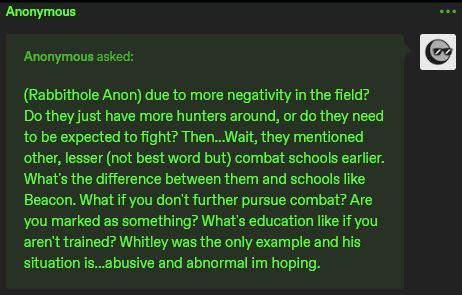
Okay, I love this rabbit hole. XD It illustrates a couple of RWBY problems here and it's the fact that they often are lacking in the character development/character journey department, and that they're often lacking in the world building department.
We actually have plenty of characters that can serve as examples for people who maybe should've thought twice about entering the Academy (when they did.) There are people who entered the Academy for the wrong reasons/not noble reasons, people who entered the Academy during a time they might not have been ready, and people who would be full on dangerous with a Hunter badge, and most of our mains fall under one of these categories (though mostly the first two.)
Ruby - Two years below the standard age of her class. Whether or not she was at the skill level of a first year (she was,) and whether or not she'd received special training from Qrow (she had,) Ruby was still essentially a kid, and her mind and body both hadn't developed completely. Ruby should have been traumatized after the Fall of Beacon and been allowed to show that more as a character, she should've had straight up PTSD, she should've been allowed to have emotion in Volume 4 than Jaune's sidekick who makes sad eyes when she sees him grieving. Weiss - Her main motivation for joining Beacon was to reclaim her family legacy. Yes, her desire was to reclaim it and use it for good, but it was still arguably more about personal and familial glory. On top of that, Weiss has been blatantly anti Faunus and has never so much as addressed that. Weiss's character journey should have reflected more personal growth, and either her unlearning much of her Faunus racism and clearly changing priorities from her name and family legacy and onto the actual people in need, or her flaws should've led her into being more of a morally gray character who displays her selfishness and pride (in a way that's actually addressed and treated like a flaw.) Yang - She expresses admiration for people like Ruby who want to help people and be kind, but her main point in becoming a Huntress was getting thrills and going where the wind takes her. She didn't join Beacon for any sort of serious purpose, and even when she rejoined Team RWBY in volume five, it was to be with her sister and not because of her own morals (not that I think she's lacking in morals, just that her main motive was different.) This could lead to her having to figure out a lot of what she actually wants, being unsatisfied with being a Huntress in Atlas, being in over her head when things get serious, being more mentally exhausted than the others after long days, etc. Jaune - Wasn't ready to enter Beacon. Idk if he just wasn't allowed to go to a lesser combat school like Signal or if he flunked out, but he wasn't up to scratch to get into Beacon and cheated his way in. On top of that, he lacked in the emotional maturity department as well when he entered. Jaune was a little more invested in his own appearance than Ruby was, but still seemed to have similar good reasons for wanting to be a Hunter. And he did grow a lot. But he was much less prepared, skilled, or equipped to deal with the training or the career and it's a miracle he didn't die in the initiation. Granted, Jaune was handled arguably better than anyone else, since a lot of this was addressed, but these days it feels like it isn't actually playing a part in his character anymore that he's way below the people around him, and I feel like it should still be impacting him. Penny: Honestly, Penny seemed very newly born during the Beacon Arc. She might have been combat ready, but she also started spilling secrets to the first person who was a little bit nice to her, and was clearly naïve and childlike. Imagine if it had been Emerald that had befriended Penny instead of Ruby. Penny dying and then getting resurrected should've been deeply traumatizing for her and it should've made her undergo some major changes and been treated with importance in the show. Qrow: Literally wanted to be a Hunter in the first place to try and learn how to murder Huntsmen. He might have changed later and it’s not exactly relevant, but he arguably shouldn't have joined when he did either. Meanwhile, Nora's just one big mystery, because we don't know why she joined, and Ren likely joined for good reasons, but neither of them have ever actually talked about their motivations. The only character we can safely say joined for noble reasons and who was up to scratch and ready when she entered is Blake, who also had good reason to not fully trust the system she was working with, so there could've been complications and character interest there as well.
Please don't get me wrong, that doesn't mean I don't think the others should've been in school, I love that they were! I just think the writers should've explored the various ways they might've been not fully ready, not completely well suited to the job they took. The characters are allowed to be flawed and to flounder and it'd make them more full, nuanced characters imo.
On top of that, we have other Hunters to look to as well, outside of our main cast. Cardin, for example, was a terrible person, still in school and already abusing what little power he had to target a member of an oppressed minority group and blackmail other kids into doing his bidding, while plotting revenge on someone for correcting him on his anti-Faunus answer to a question. People like him should not be Hunters, and he was arguably our first sign (of many signs) that the position of Hunter can and will be taken advantage of and misused by bad people. And although the After the Fall/Before the Dawn books aren't canon, while reading BTD (I haven't finished it yet,) Coco and all her team members but Velvet also struck me as people I wouldn't want to be Hunters and wouldn't want to wield any sort of power. Coco is proudly described by one of her friends as sadistic, lets her unfounded opinions of people cloud her judgement, shows respect and admiration towards criminals, and enjoys her classmates being afraid of her. Fox is self-described as sadistic as well and is a bully who tried to use a classmate's phobia against them in a brute-like interrogation. And Yatsuhashi is leagues above the two of them, but also bullied Neptune despite saying the words 'I don't want to be a bully' and threatened him.
There are so many ways the writers could've explored people who went to Beacon too soon, weren't ready, or entered for the wrong reasons. Instead, outside of one conversation in season two about the girls’ motivations and Ren exploding that Jaune cheated his way into Beacon all the way in season eight, it seems like the only take away we're supposed to get is 'all these kids are officially the thing they wanted to be in the beginning and they're all amazing at it, woo!' No acknowledgement of the fact that they could use higher education still, that some of them are still immature or naïve, that some of them are still below the combat level they should be in, that some of them kinda haven't done super well since they left Beacon (cough Ruby cough.) It's all just... Flat, lackluster. And meanwhile, characters like Cardin were written out of the show easily. We've had plenty of examples of corruption in the Hunter business, but the show hasn't paid any attention to that and still is treating being a Hunter like the only true noble goal and the only good and non-corruptible way to defend people, despite the fact that it clearly isn’t. Being a Huntress is not better or safer or more noble in-universe than being an Atlas soldier/Ace Op/Atlas hunter. I’m not saying that all of this needed to be featured, but exploring the differences in motivation and how the Hunter lifestyle affected the various mains could really flesh out their characters. Instead, by the time everyone is heading to Atlas in volume six, they all pretty much have the same reactions to everything and the same motivations and the same beliefs. The rare deviation - like Ren in volume seven and eight - is treated as bad and a mistake that must be rectified, rather than... A natural consequence of the group being full of different people with different upbringings and different motivations that result in different opinions. That sort of thing is only ever explored as a problem that makes someone lacking, and it’s really weird and it makes the show feel... Juvenile, and lacking in nuance or depth when it comes to the characters, which is a really big shame, since the characters have a huge amount of potential and exploring the differences between them and their reactions to being in way over their heads would be - I think - the natural place to take their characters? Especially because so far their storyline has been... Not the highlight of the show.
But, as for how semblances and Hunters should impact the world building, there’s a lot to say about that! They don’t explore a lot in RWBY outside of what’s relevant to the mains, leaving the world building feeling flat and like the world itself doesn’t matter much. RWBY often feels more like a video game world than anything else, which I believe @why-i-hate-rwby-now has pointed out, so credit to them for helping me realize it. There’s one large location per continent and a couple small villages where they only really talk to a town leader and village blacksmith, or encounter a fight, relevant NPCs and characters only going to certain locations that can further the plot, characters only mattering through the ways they interact with the protagonists and seemingly getting benched with nothing to do if they aren’t currently plot relevant, health bars that can be monitored over scrolls, every weapon and semblance has a name even if that name isn’t ever mentioned in show or might not really make a lot of sense, frequently encountered enemies of various threat levels who the characters can plow down without remorse because they’re not sentient or don’t have souls... The list goes on. But one of the ways that it feels very video gamey is that the magical powers actually don’t seem to impact the world.
We know people can have auras even if they don’t have semblances (Mercury, Torchwick, Watts,) and we know lots of even grown people don’t have auras (the citizens of Mantle in danger of dying of cold while our aura having mains aren’t,) but also that auras can be unlocked, by well trained seventeen year olds (Pyrrha,) and we also know that semblances can be unlocked from a very young age due to trauma (Ren, Neptune in EU) but some people are born with their semblances (Qrow and notably Blake use language suggesting they were born with their semblances,) and some semblances are passed down or hereditary (the Schnees.) Semblances can be passive (Qrow, Clover, Ironwood in word of author,) and uncontrollable, or active (almost everyone else,) and some semblances have carried personal negative effects like in the case of Qrow who was even named for being bad luck and Robyn who said people were on edge with her because she can sus out the truth via skin contact when she wants to. Also Mercury’s father was able to somehow take away his semblance.
That’s... Pretty much the extent of our knowledge and it doesn’t tell us much. What RWBY does is give each character abilities that make them iconic and different from each other as fighters, with a shield function that wears down slowly to explain how they can take certain hits and keep going while also allowing them to eventually suffer higher damage when that shield wears down. They had a character get this shield ability unlocked to explain the existence and function of it, and featured some characters who didn’t have the super powered abilities like Roman, an early enemy meant to herald in new, harder enemies who are more plot relevant, and Mercury, who makes up for it by having higher speed and functions exclusive to him through his prosthetics. And then they seemingly built a regular world unaffected by these powers. It sounds like a video game. Civilians just don’t have this power or the shield because they act as non-playable characters. In a way, it almost makes sense to me in conception, because when RWBY was originally created, it was high on visual appeal, fight choreography, and character design. The plot elements were small and the character stories seemed to be pretty simple, the only real complication to this being the White Fang plot, which has always been a major blight in RWBY. But one of the reasons why this video-game feel kinda worked at the start of RWBY was because the story and characters weren’t meant to be the focus of the story, so although the world building at the start was definitely lacking, the audience knew that things like auras and semblances were meant to hype up and add interest to the main highlights of the show: Design and fight choreography. At least that’s what I assume. But in volume three, they started to lay the groundwork for more, bigger plots, more focus on the story, the characters journeying to the outside world, undergoing personal arcs, and that’s what V4 and onward started focusing on.
To be clear, I don’t think that’s necessarily a bad thing. I started really liking RWBY for its potential and concepts after getting through the first couple episodes of V1, but I actually really enjoyed quite a bit of V4 and V5 even though the design drastically changed and the fighting had gone way down in quality because I found some of the new focus on characters and the plot to be compelling, interesting, or to also have a lot of potential (though I was let down over and over in regards to pay off later.) However, with the new focus on the characters and storyline rather than design and fight choreography, they really needed to do some legwork on fixing the aura and semblance systems and paying attention to world building and making sure the world felt well put together, nuanced, and real. And I don’t feel like they ever did that.
Why is Pyrrha able to unlock auras? Well, because the writers wanted to explain the concept of auras and used Jaune - the unprepared - to do it. But now, auras are actually an important part of the story - for example, the people of Mantle don’t have unlocked auras, so will die of cold, but it doesn’t affect our heroes because they do have unlocked auras. So who can unlock auras? Is it a learned skill or is it hereditary? If it’s a learned skill, why isn’t everyone eager to learn it especially in places where it’s life or death if they don’t like in Atlas? If it’s a hereditary skill, why aren’t the people who have that skill put on a pedestal and being pressured into using that skill to save civilians in places where having an aura is the difference between life and death? In either case, why aren’t there people who professionally unlock auras? Why aren’t they on the pay roll in Atlas and Mantle? If it’s a skill that all powerful hunters have, why aren’t our heroes (who we’re supposed to think are now more powerful than Atlas’s best) unlocking auras for dying children in Mantle? Why don’t specialists and longtime fighters with Qrow, Winter, Robyn, Maria, or James have this ability if it comes with skill, time, or talent?
Why are semblances unlocking or morphing in times of trauma so rare? Why didn’t the Fall of Beacon unlock loads of new semblances and new semblance abilities? Why didn’t Ruby get a new semblance upgrade when she saw Weiss getting stabbed? Why didn’t Weiss unlock a new semblance ability when her plane was crashing? Why didn’t Pilot Boi unlock his semblance during the same occasion? Why is it that Jaune didn’t get a semblance upgrade when the light bridges were disappearing? Why didn’t Blake get a semblance upgrade when Yang fell into the void? Why did Ren get a semblance upgrade because he was upset while with the Ace Ops after Oscar got captured, but Nora doesn’t get an upgrade while she’s electrocuting herself? If semblances sometimes unlock in times of truama, why is it that some characters like Oscar and Torchwick and Jaune pre-V5 who we know have encountered lots of trauma just still don’t get semblances? If you can train your semblance into upgrading, why is it that we don’t see long time hunters and fighters unlock more semblance abilities, like Qrow, Winter, Robyn, Maria, or James? It just doesn’t make any sense! And I get that stories always have things happening just because the writers want it, but in RWBY, the hand of the creator is so obvious that it’s ridiculous.
And then there are other questions. Do people avoid bad labor practices out of fear of causing a semblance awakening? Well, from what we see of the SDC, the answer is no. So why not? Why weren’t they worried about an uprising? Work rights becomes a lot trickier when you have to add in tons of qualifiers. Maybe it’s illegal to use a semblance at work, but the SDC also has a history of child workers like Adam who can’t always control it (like Neptune couldn’t control his,) so are there laws protecting child laborers? Perhaps not, since you know, they were already child laborers, so were already suffering unchecked. Are there laws forbidding the use of semblances in government buildings, non-combat driven schools, or parks and libraries? And meanwhile, how would any of this apply to people with a passive semblance? How do you figure out that someone has a passive semblance? How do people know if they’re born with a semblance? Are there people that spend their whole lives having semblances that never get discovered? Do people have semblance detection... Semblances, that they get paid to use or do so out of charity? Did the Schnees rise to power due to their powerful and hereditary semblance, perhaps? Are people discriminated against if they don’t have semblances or pressured to become Hunters if they discover they do have semblances? Shouldn’t civilians in Mantle and Atlas be joining combat schools in droves in the hopes of unlocking an aura so they can better survive? And shouldn’t there be discrimination against people with certain semblances? Outside of Robyn saying she’s personally experienced mistrust, and Qrow’s self-hatred, we don’t see any real prejudice against certain semblance types, or for that matter, any praise or extra significance pointed to certain other semblance types. It would go a long ways towards world building if there were things like people having to divulge their semblance or lack thereof before entering Beacon, or for people to have to register a semblance evolution, or for Emerald to have lied about her semblance because “everyone knows illusion semblances automatically draw suspicion,” or for Qrow to comment that he’d never seen Clover in a Vytal Tournament, only for Clover to say his semblance was deemed ‘cheating’ back when he was in school so he hadn’t qualified. And on the flip side, you could have things like semblances being judged as better and more powerful based on how useful it might be, Pyrrha keeping her semblance on the DL because it’ll just bring more unwanted admiration on her, Sun keeping his own semblance on the DL too because it always make people put a lot of expectations on him, while Neptune’s semblance leaks and he deals with people treating him like he’s selfish and cruel for not wanting to use his own “gift of a semblance.” And people like Jaune could be bullied extra because he doesn’t have his semblance yet, and people in the stands at the Vytal Tournament could be chatting about “when are they gonna pull out their semblances?” and get annoyed and pouty when people don’t. To be fair, we do get things like Mercury’s father having declared his semblance a crutch, but... Still. why isn’t there more of this?
And we see the need for Hunter protection in villages like Kuroyuri and the village that Team RNJR stops to help on the way to Mistral. Small villages outside of the four kingdoms fall to Grimm, or are in danger of falling to Grimm. Ships get attacked by large and dangerous Grimm, we see (corrupt) Hunters on the train to Argus, accompanying for safety, and we see that with a rise of Grimm activity in Mantle, Hunters are dispatched to help kids travel to school. In a world like RWBY, fighting is essential for survival outside of the Kingdoms, and became very essential in the kingdoms as well once schools started going down. You’d assume there should be Hunters accompanying everyone traveling outside of the Kingdoms, resident Hunters living in villages outside the Kingdoms as their on-hand protectors (and more than one Hunters seems to be needed.) Hunters also could be extra protection for anything that’s definitely going to increase negativity, like hiring Hunters to bodyguard funerals seems like something that could be normal in the world of Remnant, and for visiting graveyards (we see Ruby get attacked by tons of Grimm when she visited Summer’s grave in the red trailer.) On top of that, celebrities and rich people hiring Hunters seems like it’d become pretty common. But all that we see outside of Dee and Dudley are traveling Hunters stopping to help people out of the goodness of their heart while they go place to place, and Kingdom Hunters who are assigned to things like border control, clearing out Grimm near or in the Kingdoms, and things like that. What we see is a Kingdom-centered morality complex our protagonists are one hundred percent invested in, Hunters are Kingdom driven and anything outside of that is a kindness, a job they can take or leave in passing. And on top of that, it seems like there aren’t a lot of people in the Hunter profession, and I feel like there should definitely be more. There are people like Jaune who didn’t make the cut but accepted that, we can only assume that there are drop outs too, so like... How many kids are there actually in a year at Beacon? I mean, look at where the Relics were found in the forest during initiation at Beacon.
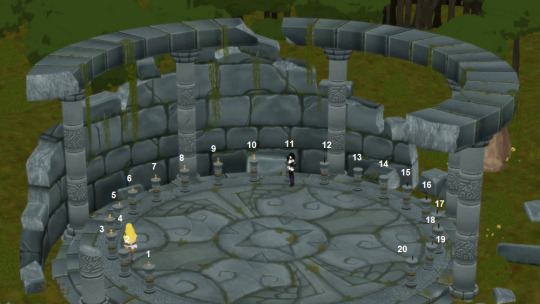
This gives us a rough idea of how many people are in each year at Beacon. Assuming everyone graduates school and there’s no drop outs and no deaths, that’s a graduating class of twenty. That’s a very small number, comparatively. The job of a Hunter is dangerous. We know of Hunters that died (Summer, Pyrrha, Amber.) We know a lot of Hunters that have other jobs that take a lot of their time (Glynda, Ozpin, Robyn,) and lots of people who quit being Hunters too (Maria, Tai, Raven,) and Hunters who aren’t always on the field like Qrow who was a teacher for a stretch and acted as Ozpin’s spy, the Ace Ops who became part of Ironwood’s inner circle and therefore had a bigger picture, and even all of Team RWBYJNR, who got their Hunter licenses but are also more concerned with bigger picture stuff (if you don’t believe me just look at volume eight where JRY stopped defending Mantle to go rescue Oscar, and Team RWBN + Penny, who were involved in big picture stuff like launching Amity and then saving Penny the Maiden/their friend.) So out of a class of twenty, how many of them are even staying on the field? For a show pushing the narrative that Hunters are the ultimate saviors who are the only true good defense for the world, that condemns even the notion of an army... Like they villainized sending Team FNKI onto the battlefield while also treating it like proof of Ironwood’s evil when he didn’t want to stay and fight when Team RWBY said to, and also made Ironwood’s desire to move into having a robotic army to get soldiers off of the battlefield part of his... Over reliance on machinery, which is full on suspicious considering their ableism towards Ironwood and the fact that he literally has to rely on machinery, but that’s a topic for a different post and this one is already so long. But yeah, my point is that we’re meant to see the army as bad. So if we’re meant to see Hunters as the only true and pure form of defense (which is already off because we know it’s corrupted,) there ought to be way more people in the Hunter field.
As for the schools, we only know of a couple of schools that exist outside of RWBY as combat schools that seem to act as basic training before people go to Beacon. We know of Signal, the school Ruby and Yang went to that Qrow was a teacher at for awhile (I have lots of teacher Qrow headcanons, but sadly Qrow being a teacher wasn’t very well explored,) and we also know of Sanctum in Mistral and (in the EU) Oscuro in Vacuo, presumably one of these existing in Atlas as well. I personally headcanon that there are a lot of these smaller combat schools littering the whole of Remnant (but then again, I also headcanon that the Kingdoms of Remnant are bigger than just one very large city, lol) and that a lot of people attend these schools even if they don’t go on to join one of the Hunter Academies, but this isn’t necessarily supported by canon, I think. But as for other schools...I think it’s fair to assume that there are at least elementary schools, since everyone can read, write, and presumably do basic math, and what we do know is that Ilia went to a prep school in Atlas (which was info dropped in Blake’s pre-V5 trailer, not even stated in the show proper,) so we can probably safely say that people who don’t go to the Huntsman academies go to some form of high school, but you’re right that we don’t see this actually in action. I personally always headcanon that Whitley had a tutor, since Jacques wanted to avoid too much outside influence.
I am so sorry that this response got so away from me and I myself got into so many rabbit holes as well. XD I just have a lot to say about the world building in RWBY (or sometimes lack thereof.) Although I admit that I’m not as into or as good at analyzing as blogs like why-i-hate-rwby-now, but yeah, this is... A very long post. Sorry!
#rwde#anti rwby#rwby bashing#rwby hate#this post includes some#pro ironwood#pro james ironwood#also it's not like I've done a lot of extensive research so please be kind#if I missed something#IW antis please leave me alone
24 notes
·
View notes
Text
8 Lessons from Vipassana
2010 was a peculiar year. It was the year in which I found the great fortune of stumbling upon a book about the bizarre incidents and experiences of an Australian girl voyaging through the Indian subcontinent. The book — a 21st century rewrite of the lore of the hippie trail, offered little towards cerebral surprises, but made for a curious viewing of the life of someone who was brave (or foolish) enough to have gone through all the trouble that she did for the experiences she sought.
The author chronicled days spent discovering religion and spiritual heaven while avoiding hell — nosy neighbours, opportunistic rickshaw-wallas, and the odd would-be rapist. She portrays an all too familiar India — the world’s spiritual shopping mall serving food-poisoning on Tuesdays, vehicular accidents every Friday, and frightening latrines as a daily course. Not all of her pages carried so much drama, but they laid out a rough sketch of the trials and tribulations of the average foreigner in attempting to make sense of the country.
The smallest chapter in the book spoke to me the most. There was a tiny passage that depicted the joy and punishing solitude of the type rarely considered as thrill — monastic rituals, austere and rigorous routines, distress and hardship — it seemed a bit too much for anyone, let alone a solo adventurer. And yet, it seemed like just about the only thing she really enjoyed during her trip.
That was my introduction to Vipassana. That first memory is still fresh: the desire to confront this awkward specimen of a situation for myself, only because, at the time, it seemed so bizarre. To my ignorant mind, I could not have comprehended the result of ten long days (and nights), sitting around without the utterance of a single syllable. If nothing else, it would just be yet another substance: to taste, chew on, spit out, and rave about having conquered yet another mountain of sensory input; spin it all into a tall tale of profundity and wisdom.
Thankfully, the taste was sweet. To me, this became pretty important. It felt like a gigantic discovery and I often found myself proselytizing like a broken record for days after the first course. I eventually stopped for being seen as a bit of a nuisance, however, my fascination with the practice only grew with time. In those ten short days, I had experienced a deep, resounding change from within. As difficult as the journey had been, I only knew I had to keep going.
That was all ten years ago. 2010 was peculiar, but a dozen Vipassana courses later, life only became weirder.
It’s the stark contrast that gets you; the juxtaposition of life inside a course, and then witnessing the world outside. It is hard to illustrate and is not really the point of this post, but I mention it only because I’d like to warn you that many of the lessons I’ve learnt are all experiential truths. Simply engaging the intellect is not enough. You can’t describe the taste of salt to someone who has never experienced it before, and you can’t learn to swim simply by reading about it.
With that said, understand that even though I have been practicing for a while, it does not mean I have achieved any form of mastery over my practice. I still consider this as the just the first step in a very long path. I share these insights, all of which have broadened and enriched my understanding of not only myself, but of all-encompassing experience existence in itself. My only hope is to encourage you to sit down and focus on your breath.
1. Relaxing meditation is more like aggressive deconditioning…
The mind is a big ball of accumulated, tightly-knotted habits. Habits are not merely mundane proclivities like picking your nose, or a preference for K-pop. Habits are the set of all unconscious tendencies, picked up over the course of one’s life and through generations past, resulting in present thought, action, or both. Natural instincts such as the struggle to survive and the urge for sexual gratification are among the densest of elements residing within the mental landscape.
Mental forces are easiest to imagine when you think of them as analogous to Newton’s Third Law: each action has an equal and opposite reaction. As the mind sees, the mind does. Cause and effect. Through millions of years of evolution, the mind has been shaped to recognize and react to patterns. Certain emotions may result in specific thoughts. Certain thoughts may result in specific behaviours.
When you sit down to practice Vipassana, you essentially train yourself to observe the mind without reacting. The process may not seem like much but, with time, the simple act of observation decreases the rigidity and impulsiveness of the mind. Gradually, the simple act of watching it unravel before you, unveiling its knots until they loosen and eventually fade away, brings about a significant change. This does not mean that after ten days of meditation you will deprogram your mind and achieve liberation. It is a very gradual process. Believe me. Even after all these years, I’ve only scratched the surface and, so far, I’ve managed to adopt a slightly better diet. But I have better focus, more clarity of thought, less anxiety, and things that used to drive me crazy don’t annoy me as much anymore.
Meditation will change your brain. Thoughts included.
2. You are your mind’s weak, pathetic slave.
At any given time, you have very little conscious ability to overrule your genetic programming, emotional state, and natural surroundings (many have even argued that there is no such thing as conscious control and free will is an illusion, but that is a discussion for another time). The goal of meditation is to break free from the mind’s thrall: it’s patterns of thought. That’s the liberation that meditators keep referring to time and again.
If you find it hard to believe how little control you have over your mind, try to focus continuously on the breath just for a few minutes and notice the amount of thoughts that manage to pop up. You’ll quickly see how easily the mind is carried away. It’ll drift away, either to the future, or to the past. Bringing it back and keeping it in the present is a constant, seemingly endless struggle.
Our toxic addiction to our own thoughts creates the biggest hurdle. Over the course of our lives, we have been conditioned by our parents, school, society, even language, to think a certain way. Like the words we associate with objects to learn the alphabet in kindergarten, we continuously associate abstractions — words — to ideas; to the way things work. Our names for objects, people, places, feelings, situations, etc. are just names. They are concepts that are formed in the mind. In other words, our brain holds maps to reality which are drawn and redrawn over the course of our lives. But the map is not the territory, yet we are constantly under the delusion that the map is real.
Our fascination and attachment to our artificial concepts of what is real, important, and urgent is what hinders progress— the practice is essentially training the mind not to identify with one’s thoughts. In other words, to heal trauma, you need to learn to dissociate with the feeling which triggers the trauma. Trauma comes in many shapes. It may take the form of the stories that we forge for ourselves to make sense of who we are. The story we tell ourselves turns into the very bondage that keeps us in indefinite servitude to the mind.
The mind is a slippery serpent, as dangerous when untamed as it is powerful when mastered. Most beginners often find it frustrating how difficult it is to ‘control’ their minds. But therein lies the effort. It is a skill to be cultivated like any other. Exasperation and the desire to stop is a natural byproduct of the conditioning described earlier. There is an inertia to progress that needs to be continuously overcome. With time, it gets easier.
Meditation is simply a tool to harness and rein in the unruly mind.
3. Everything is connected. Every action has a consequence, and it matters.
This can be argued as a simple scientific principle. Richard Feynman in his lecture, “The Relation of Physics to Other Sciences,” describes the artificial divisions we create, forming a myriad of distinct models of understanding to comprehend and explain to ourselves aspects of the same reality. Brian Cox takes it even further.
My understanding leans towards the philosophical side, but bear with me. Most religions and spiritual traditions preach purity of mind, speech, and deed. Whether through scripture or ritual, they teach compassion, loving kindness, mercy and wisdom. I’ve realized that there’s more to this than mere morality.
To greatly simplify this, let’s imagine the world as a closed, finite system — something like a small swimming pool. Any kind of movement results in ripples that gradually extend across the body of water, affecting everything in their path. Eventually, given enough time, those ripples will bounce right back to whence they came. Sooner or later, your actions will meet their maker. But don’t mistake this as a need to be nice out of selfish necessity. The picture is bigger than this.
The world, much like our hypothetical swimming pool, is a melting pot of events resulting from simultaneous interactions causing countless, spontaneous consequences. It’s a chain reaction and an ocean of chaos, with the ebb and flow of individual currents that mingle, coalesce and form waves, crashing into one another to give us the great churning of the wheel that Buddhists speak of, and the agitation that we are almost too familiar with.
The turbulence, in essence, is the mind being washed away with the tide, engulfed and drowned in the vicissitudes of a constantly changing life. To remain steadfast and solid in such stormy waters would require nothing short of supreme mastery in the art of mindfulness. A cornerstone of such an endeavour requires the cultivation of a conscious effort to sustain complete awareness and acceptance for the present moment.
When one remains vigilant of thought, speech, and deed, and acquires a resolute and unwavering focus, then all the torment the ocean can muster will be but powerless against this tranquil state of mind. But even beyond that, tranquility will give way to reflection, understanding, and empathy. In other words, when you respond to anger with love, you cast water over the fire.
With practice, each action undertaken will arrive with more effort, more purpose and consideration. That is the delicate insight to be gained — that every action, every moment, every breath is sacred. Every bit of conscious presence is a gift to be treasured.
4. Nothing matters as much as you think it does…
Vipassana meditation is an exercise in cultivating insight through self-observation. You watch your breath and the sensations across your body as they arise and pass away, each time acknowledging their transient and impermanent nature. That, you come to realize, is the truth of all reality.
You realize that suffering is a form of mental attachment, not to any external object, but to the sensation that object has on your mind. This attachment is sometimes so subtle and imperceptible that it is impossible to witness it without a mind that is steady and calm. These attachments are what cause dukkha or suffering. Attachments are not limited to sensations that feel good. Any sensation that makes you feel like had more of it or less of it — desire and aversion — is attachment. The mind runs after pleasure, runs from fear and pain. These are attachments and they are a hindrance to the practice.
As you grow into your practice, you will gradually slip out of your old patterns of thought, replacing them with a more open, willing, and fluid presence of mind. What once bothered you may gradually dissolve into nothingness. What once seemed as part of you, possessed you, caused emotional havoc when you didn’t get what you wanted, might simply vanish from existence. No, you won’t turn into an emotionless robot. No it won’t make you give up everything in life, turn into a vagrant and move to the beach, unless you already desired those things. Meditation will only help sort out what you really want.
Practice will help you detach yourself from your thoughts until you realize that your thoughts are not you. Feelings come, feelings go. They are impermanent, and they don’t matter. All it requires is time and the simple act of observation.
5. You are not an experiential bubble.
For many beginners trying to embrace the many forms of mindfulness, one of the toughest obstacles to overcome is doubt. It may be doubt in oneself, doubt in the practice, doubt in one’s teacher, and so on. But it’s a natural response to something new, especially to those completely unfamiliar with these types of practices. Imparting trust is a transactional habit. Unless one is certain of attainable benefits and can measure their worth, they may find an unwillingness to take even the first step.
Couple a doubtful mind with the myriad of mental encounters one may face during meditation and the result might just kill the desire for practice. People have reported everything from swirling lights, out-of-body experiences, synesthesia, to demons. This is not unusual. Meditation is a gateway into the unconscious — a surgical procedure as S.N. Goenka, the person who brought the teaching of Vipassana back to India, describes. Through the process of Sankharupekkha (observing mental formations with equanimity), the practitioner encounters dormant impurities in the unconscious that rise to the surface of the mind, and manifest themselves as physical phenomenon.
Juxtaposed with modern-day culture, the meditative experience stands out like a sore thumb, often causing its students great confusion and mistrust in the very quality of what they are learning. It doesn’t help that the ideas and general philosophy presented by spiritual traditions are outright antithetical to “western” schools of thought.
Concepts such as avidya, anicca, dukkha, shunyata, samsara and nirvana are like salt. These are concepts that are almost impossible to understand through mere language—one must personally taste them. They are often horribly misconstrued and usually thrown out, replaced by a far shallower understanding that barely skims the surface of the teaching, conflating meditation with stress reduction and labour productivity. After all, these are the values our industrial societies can easily relate to.
We often make it harder on ourselves by letting our experiences fester. Remember to talk about them, discuss them, debate their true essence, and let them be out in the open. Let these ideas, however alien, achieve coherence and solidity. Give them a better chance to struggle and survive. There are many people out there experiencing the same reality, watching the same movie, feeling the same thing. The emotional outlet, especially when you are starting out in this practice is immensely valuable. It’s a small thing but it matters.
After my first ten-day Vipassana course came to a close, as the new students could finally open their mouths and start speaking with each other about their ten days spent in silence, we could all see the benefits this strange new thing had given us. I was in a room full of fifty-odd people that seemed to have had a similar experience in the course as I did. They all seemed calmer than on the first day, happier for having made it through; in the process, they had visibly changed. That’s what brought forth trust in the system; not only because it seemed to work across a diverse set of people, but because it made me realize that we are all in the same boat.
6. Compassion takes practice.
There is no absolute right or wrong. Understanding which is which requires not only context but patience. An impulsive and ignorant mind does not have the capacity to form correct judgement. An angry and intolerant person cannot be trusted to make rational and thoughtful decisions. Why do you need to develop proper judgement? The simplest possible answer: to progress in your practice. Hence, while Vipassana may bring insight, on the last day of each course, students are taught a slightly different type of meditation.
Metta, meaning ‘loving-kindness’, is a type of meditation that involves concentrating on directing love towards ourselves and others, even those (especially those) who may have hurt us. A daily practice of metta has its benefits, but most significant of all, is the way it complements insight meditation and brings out lasting, positive changes in mind and body.
The feeling is hard to describe, but all I can say is that (at the risk of sounding cliched), through the course of one’s life, pain is an inevitability, but suffering through the pain is a choice. With regular practice in metta, instead of being swept away by one’s emotions, one learns to consciously bring awareness to the suffering being experienced and replace it with compassionate and loving thoughts. Suffering is simply a negative reaction of the mind to any form of pain. With practice, mental aversion to pain gradually fades. Like mental ointment, compassion can heal the deepest of wounds.
But compassion takes practice. Think of it as learning a new language. Even if you have no prior experience reading the script or pronouncing the words, with time, you might just achieve fluency.
Compassion towards all beings, regardless of the situation, is an important goal for anyone serious about walking the path. When you emanate a constant stream of loving thoughts without ever missing a beat, then you might definitely consider yourself having changed for the better.
7. It’s all just glorified play.
By the time children reach the age of 3 or 4, their ego begins to form a cohesive identity — a map of themselves: I am this, I like that, I want to be so and so. Whether through nature or nurture, the child learns to take on a role for themselves depending on what the situation may bring: during interactions with their parents, with other children, and with society in general.
From an early age, children are engaged in play. Their games may be diverse, but are usually a form of role-playing: tea parties, dollhouses, make-believe — simulations of the adult world, to test its boundaries and see how things react. Fueled by curiosity and the joy of discovery, they rehearse and solidify their understanding of their surroundings, finding their place in the greater familial and societal picture, and simultaneously strengthen their masks of identity.
The masks we carry, birthed from the ego, may be necessary for our survival, but they are simply roles — the games we continue to play even as adults, with ourselves and with others. When the student of Vipassana comes to notice their own desires and attachments to the world, the identity of the self is often seen as the greatest attachment. It is the great epic; the story of ourselves that we’re so engrossed in writing and reciting— and madly in love with.
This story never ends. It lies permanently in the state of becoming: I am like this, I like that, I want to be so and so. The attachment to a false idea of oneself is the most difficult thing to witness and understand. It is the biggest delusion of the mind, and the greatest hindrance to one’s liberation from samsara — the endless cycle of birth and death. Whether you choose to believe that is unimportant, but recognising one’s tendencies to cling to one’s beliefs, one’s masks and identity, is a crucial process towards self-discovery and insight.
Recognising the mind for what it is — a constant stream of consciousness always in flux — will bring you a step closer to deciphering it.
8. You Know Nothing.
I know nothing. For knowing involves being certain, but if everything is impermanent and things are constantly in flux, then nothing can be certain.
To understand how truly inept we are at comprehending reality, consider the incredibly narrow spectrum of perception our brains provide. Our sensory organs: the eyes, ears, nose, tongue and skin offer only a slice of all the information that they come into contact with.
The eyes, for example, see only a thin slice of the electromagnetic spectrum, which we call visible light. Similarly, our hearing is restricted to frequencies of sound that fall between 20 Hz and 20 kHz. In the same way, we carry only a limited cognitive capability and intelligence.
It’s a humbling thought. At the very least, reminding oneself of the fragility of one’s understanding is a way to minimize cognitive bias. Further, since no one knows anything, knowing you know nothing will actually put you a step ahead of most people.
“I am wiser than this human being. For probably neither of us knows anything noble and good, but he supposes he knows something when he does not know, while I, just as I do not know, do not even suppose that I do. I am likely to be a little bit wiser than he in this very thing: that whatever I do not know, I do not even suppose I know.” — Plato’s Apology of Socrates
Similarly, from the Dhammapada:
“A fool who knows his foolishness is wise at least to that extent, but a fool who thinks himself wise is a fool indeed.”
Lastly, Shunryu Suzuki, a Japanese Zen Master calls the state of knowing nothing the “beginner’s mind,” the constant prerequisite for progressing in one’s practice:
“The goal of practice is always to keep our beginner’s mind. This does not mean a closed mind, but actually an empty mind and a ready mind. If your mind is empty, it is always ready for anything; it is open to everything. In the beginner’s mind there are many possibilities; in the expert’s mind there are few.” — from Zen Mind, Beginner’s Mind
May all beings be happy.
9 notes
·
View notes